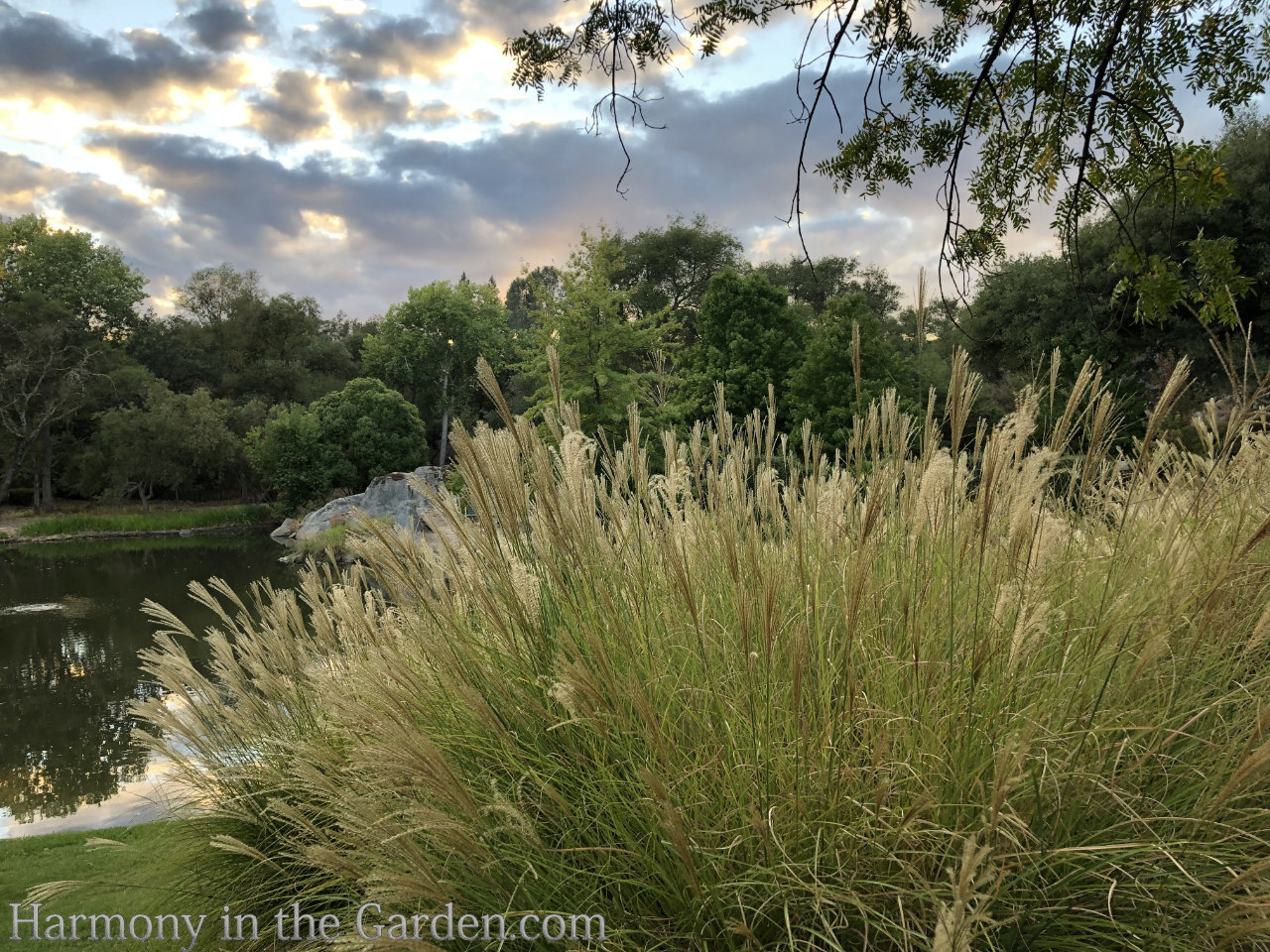
I’ve been designing with ornamental grasses for decades and consider them an indispensable staple not only in my own garden but in those I design.
However, when meeting with new clients, I’m always amazed at how often I hear something along the lines of ‘I really like grasses, but I’m not sure how to use them in the garden.’
I wonder if part of the resistance is because there are SO many varieties on the market now that choosing the right grass is a bit overwhelming.
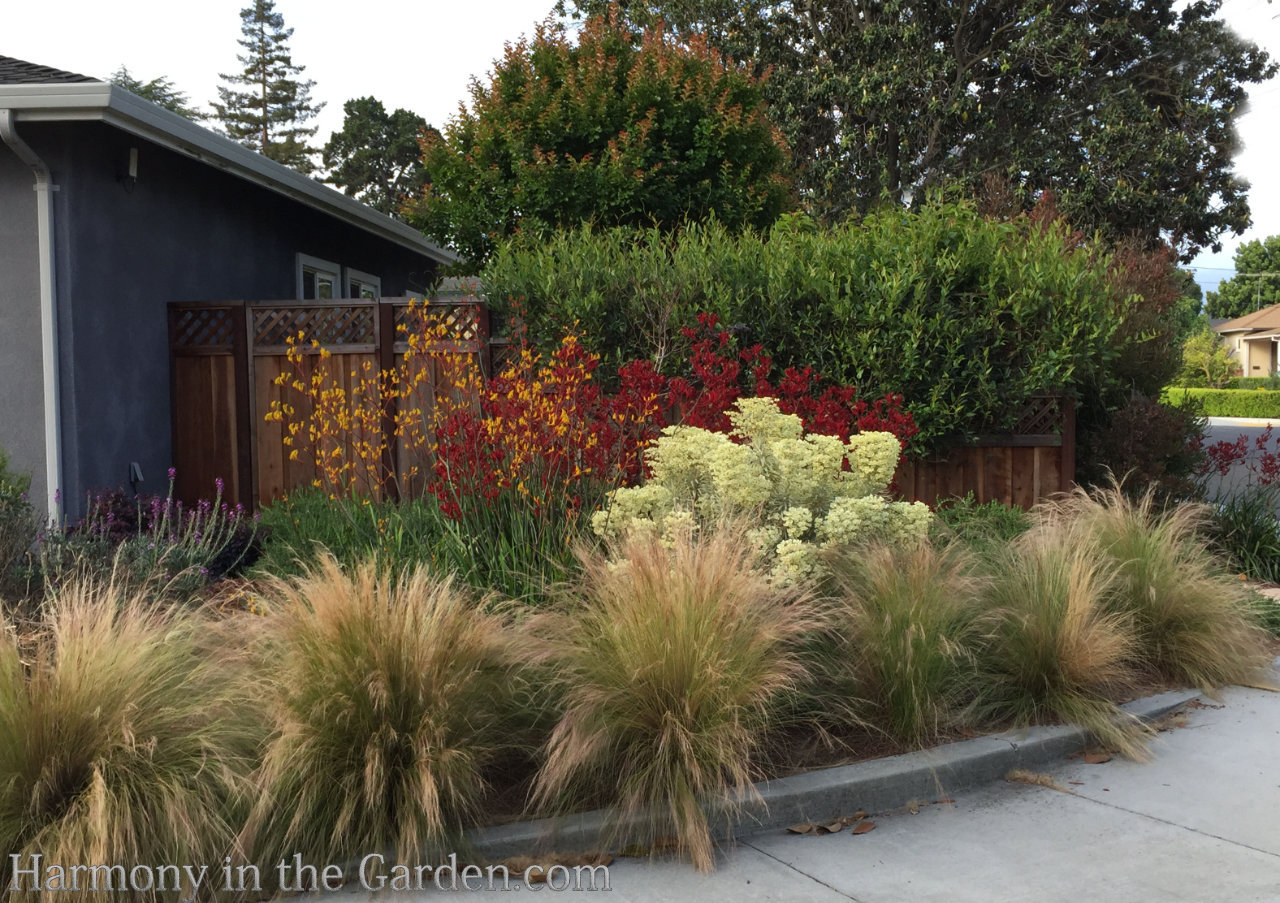
Or perhaps some gardeners are reluctant to use grasses as several can be problematic with their rampant re-seeding.
In my zone 9 climate, two often used but incredibly invasive culprits are the Mexican Feather Grass (left) and Northern Sea Oats (below.)


At this point, I begin to explain ways grasses can be used in their garden and why they’re missing out on an amazing group of plants.
For example, most of the grasses I use are drought-tolerant and thrive in our hot and dry environment.
And, when I mention that most grasses are deer and rabbit-resistant, those who are reluctant usually jump on board.
In fact, deer never touch any of the grasses in my garden. I’ve been trying to think if I’ve ever had a grass mowed down by a deer or rabbit, and I can’t think of a single instance.
Appreciating the qualities of grasses is one thing, but understanding how to design with them for maximum impact is another.
So in this post, I’ll share with you my favorite grasses that have done really well for me over the years and how to use them in the garden.
For clarity’s sake, I’ll be discussing grasses and grass-like plants. I’ve always liked this well-known saying that helps sum up the differences between sedges, rushes and grasses:
‘Sedges have edges, rushes are round, grasses have knees that bend to the ground.’
So let’s proceed!
Bottom Layer
These are the grasses that grow between 6-12 inches tall. They’re ideal for tucking along the base of taller plants, nestled next to a rock or container, or even filling in between stepping stones.
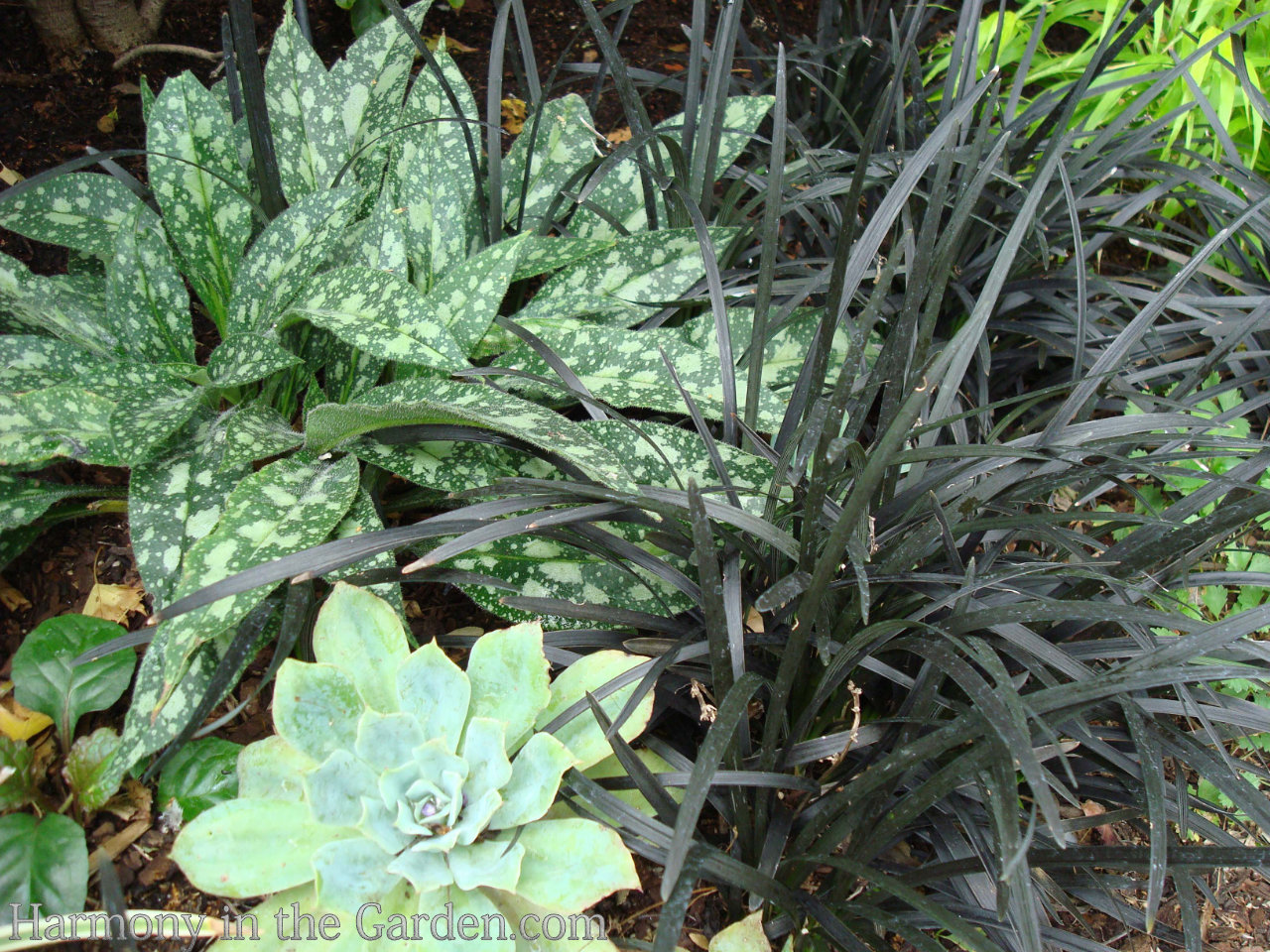
Black Mondo Grass (Ophiopogon planiscapus ‘Nigrescens’) zones 5-10
I love gardening with unusual colors, which is why the black foliage of this 6″ grass is welcome in my garden any time!
To prevent the color from getting lost, I make sure to place it near gray, blue, or lighter green foliage.
For an even smaller mondo grass, try ‘Nana,’ which grows to just 2-3″ tall, making it perfect for filling in between paving stones.

Cinnamon Sedge (carex tenuiculmis ‘Cappuccino’) zones 7-10
The cinnamon/brown color of this sedge is one that I love to use in creative color combinations.
Brown is a tricky color in the garden, as it can easily fade into the background (especially when surrounded by mulch, or if it’s in a shady area.)
The trick is to place brown colors (black plants, too, for that matter) near brighter greens to help the color ‘pop.’
Or, in the case of my front entryway garden (left) it’s the vibrant fall foliage of the amsonia that harmonizes with the brown carex.
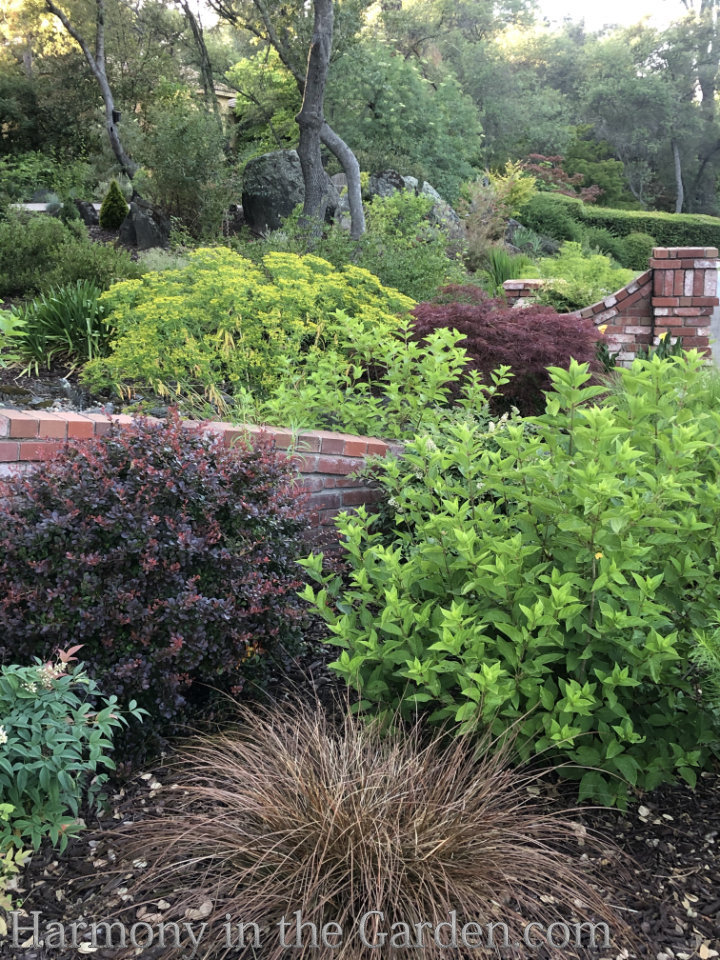
Here’s the same carex in the spring, where I’ve placed it near bright green and dark burgundy colors.
I’ve drawn a yellow line to help demonstrate the burgundy/brown color echo I created between the carex, berberis, and Japanese maple.

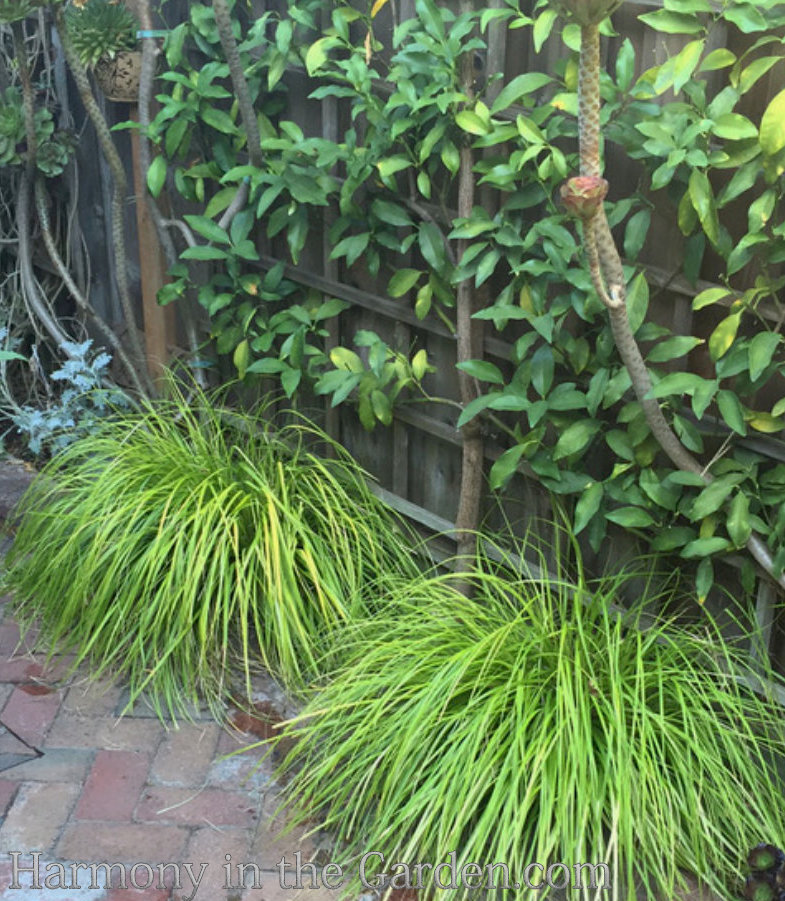
Everillo Carex (c. oshimensis ‘Everillo‘) zones 7-10
Over the years, there’s been a lot of different chartreuse carex varieties introduced, but ‘Everillo’ is my favorite.
The bright chartreuse color doesn’t fade to dull green as fast as most varieties do, and it seems to do really well with summer’s hot temps.
I like to use it in shadier parts of the garden as the foliage brightens up the space, acting as the ‘missing sunshine.’
As a whole, carex grasses tend to appreciate consistent watering (some more so than others) but once established, ‘Everillo’ does fine with moderate watering.

In my zone 9 garden, most carex need a fair amount of protection from our blistering sun.
If you live in a cooler zone, however, you can certainly plant them in more sun.
Carex grasses are particularly stunning when massed, creating a soft and mounding drift (as is seen here, at NYC’s High Line Garden.)
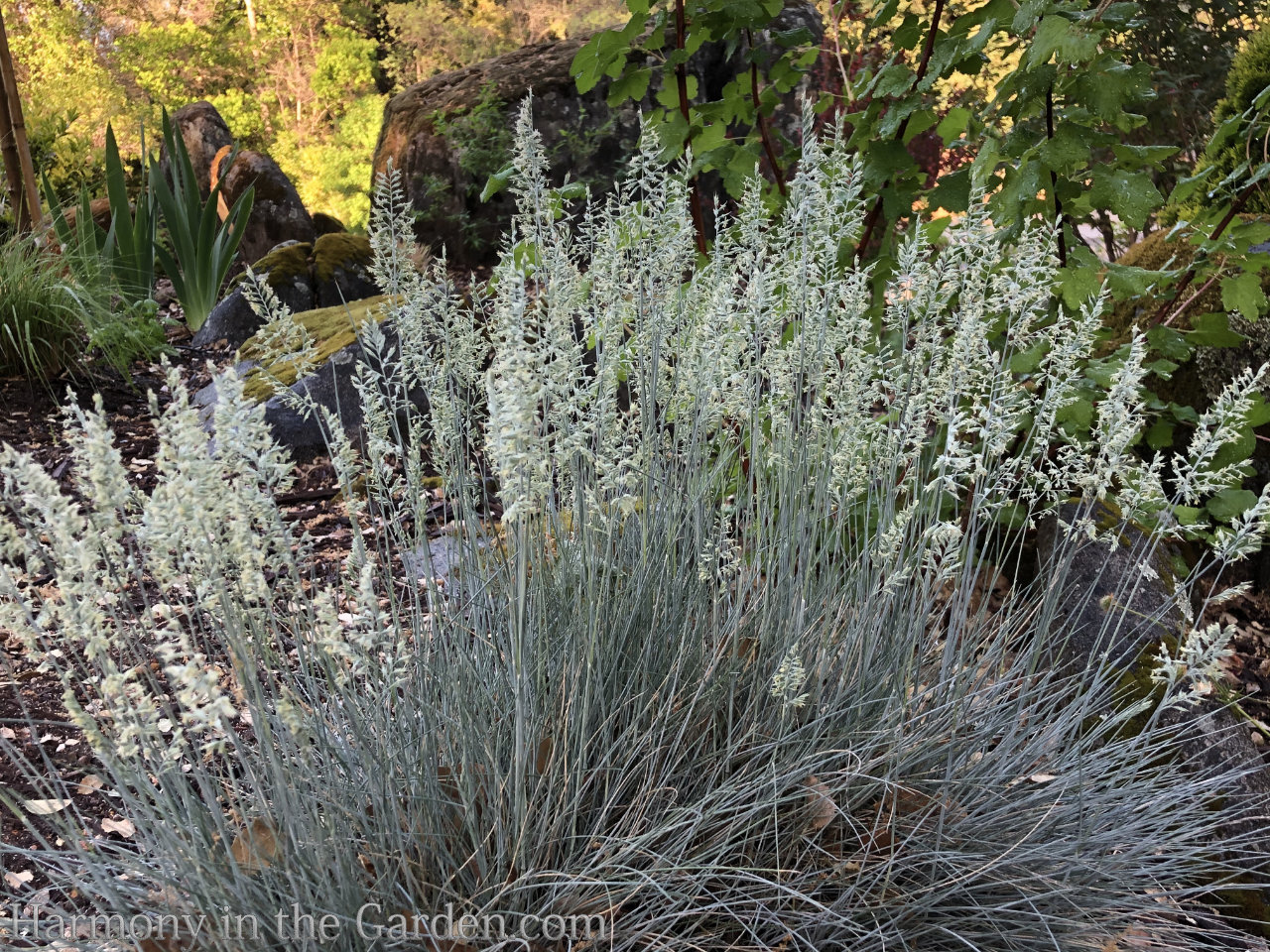
Blue Fescue (festuca glauca) zones 4-11
There are so many varieties on the market, but my favorites are ‘Beyond Blue’ and ‘Elijah Blue’ as they have the richest colors.
These grasses grow to 12-18″ tall and are tough as nails.
Plus, they produce the cutest flowers (they’re technically not flowers, but ‘inflorescence.’)

When I first moved to my new garden, there was a lone blue fescue, thriving on its own without any irrigation.
It may have had some at one point, but the garden was so neglected whatever water was once there was now long gone.
I was so grateful for its tenacity, I left the fescue in place and planted around it.
I surrounded the fescue with the maroon foliage of hibiscus ‘Perfect Storm’ and lavender flowers of the stokesia ‘Blue Frills’, which lets the fescue’s blue colors shine.
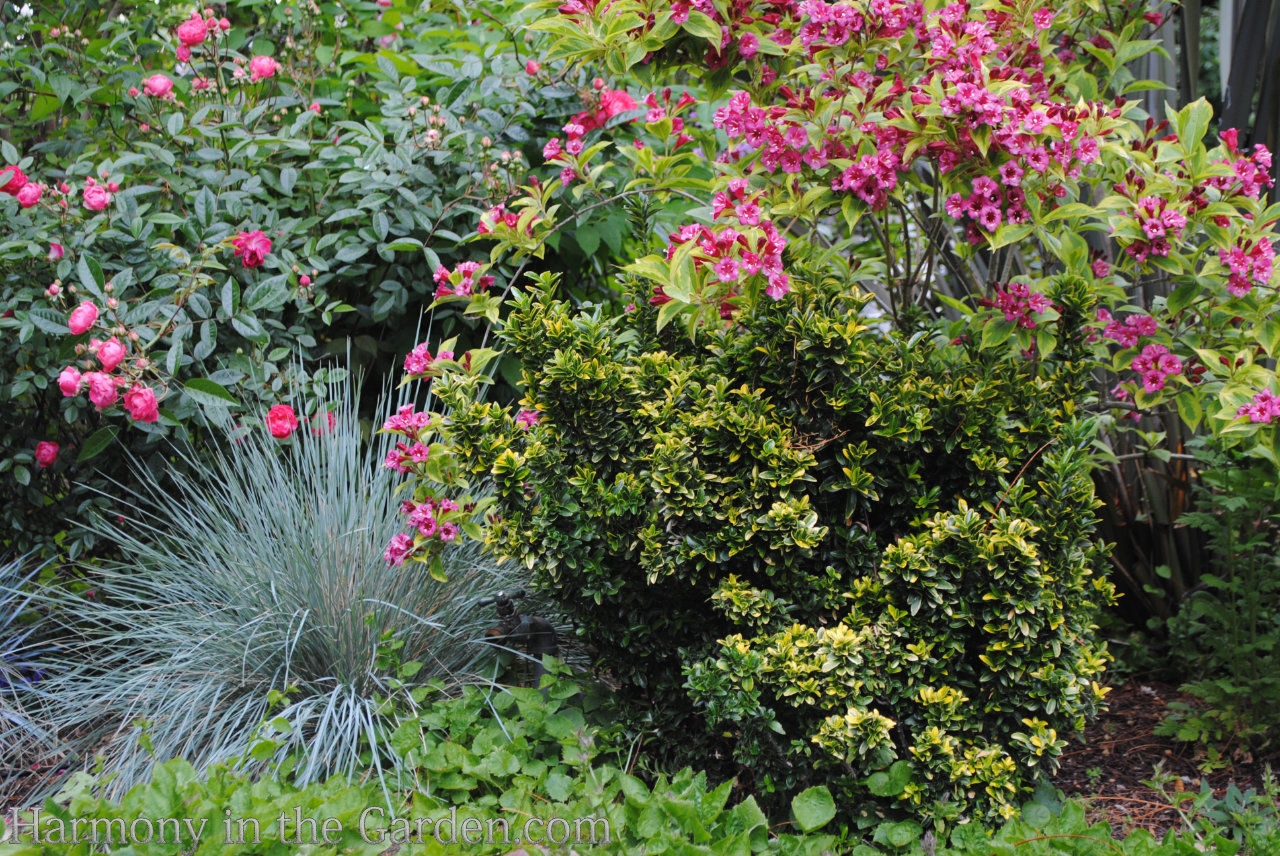
I particularly like the way the finely textured foliage of this fescue contrasts with the bolder leaves and flowers of neighboring plants.
This contrast helps both plants stand out just a bit more than they would on their own.
The flowers in this photo are pretty enough, but an eye-popping combination is created when nestled against the blue fescue.
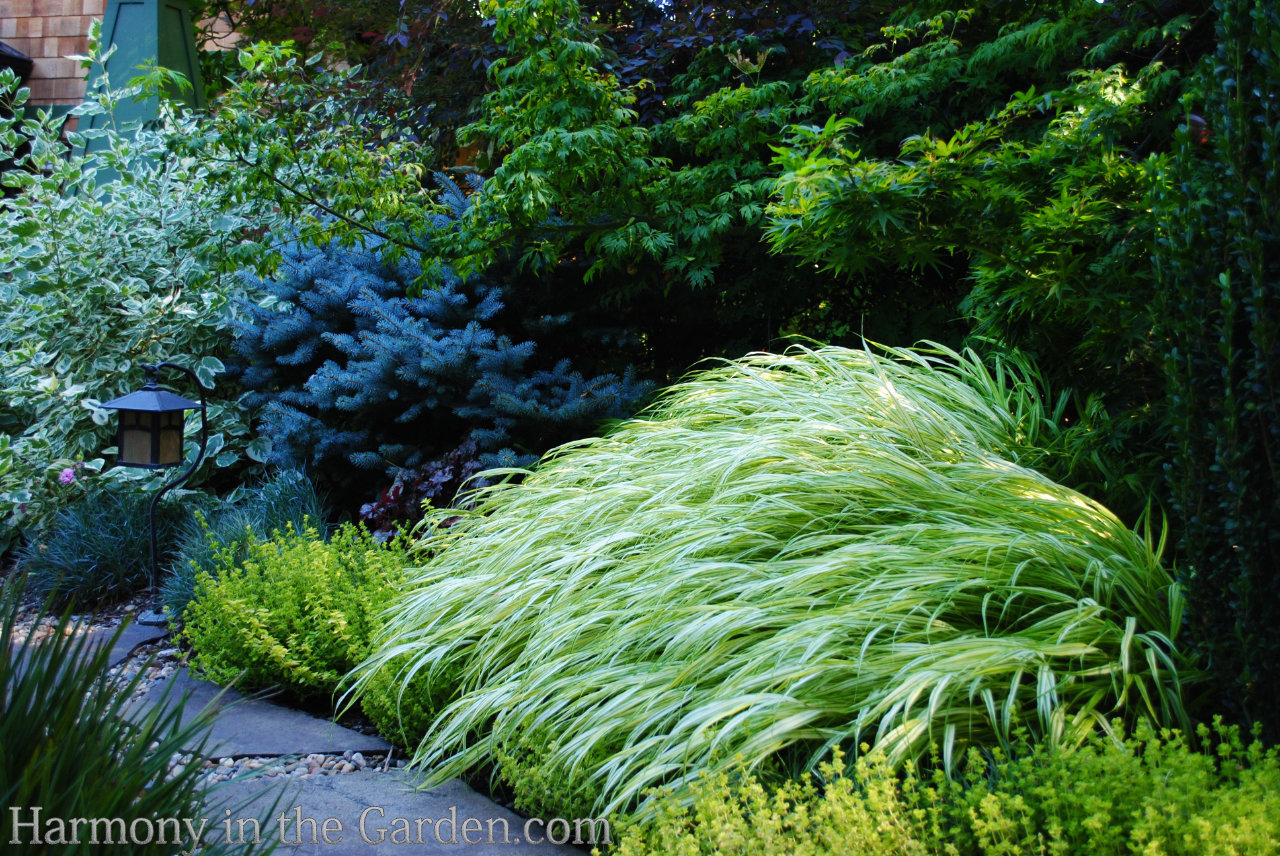
Japanese Forest Grass or Hakone Grass (hakonechloa macra) zones 4-11
In my opinion, nothing beats a Hakone grass for adding motion to the garden. Just take a look at the ‘crashing wave’ effect of the Hakone grass (right) in the stunning garden of Freeland & Sabrina Tanner.
It wasn’t even windy on this day, yet it still provides the illusion of motion.
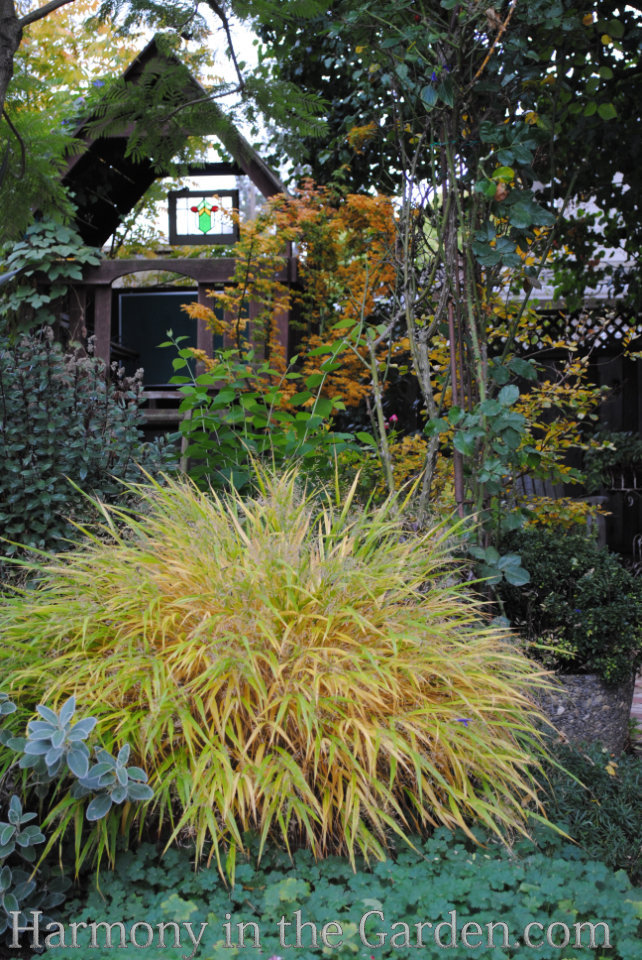
I have several Hakone grasses in my current garden and am pleasantly surprised at how drought tolerant they are once established.
Mine get no more water than the rest of my plants, and they’re perfectly happy (in the shade, of course.)
I even have one that’s been here forever and receives a ton of reflective heat from a surrounding patio.
I thought it would burn to a crisp in our hot summers (despite having shade from an overhead plant,) but it looks fantastic every day of the year.
The fall color is the icing on the cake, with brilliant shades of yellow and gold.
In my former garden (left,) I used the grass’s fall colors to create an echo with the colors of the Japanese maples.
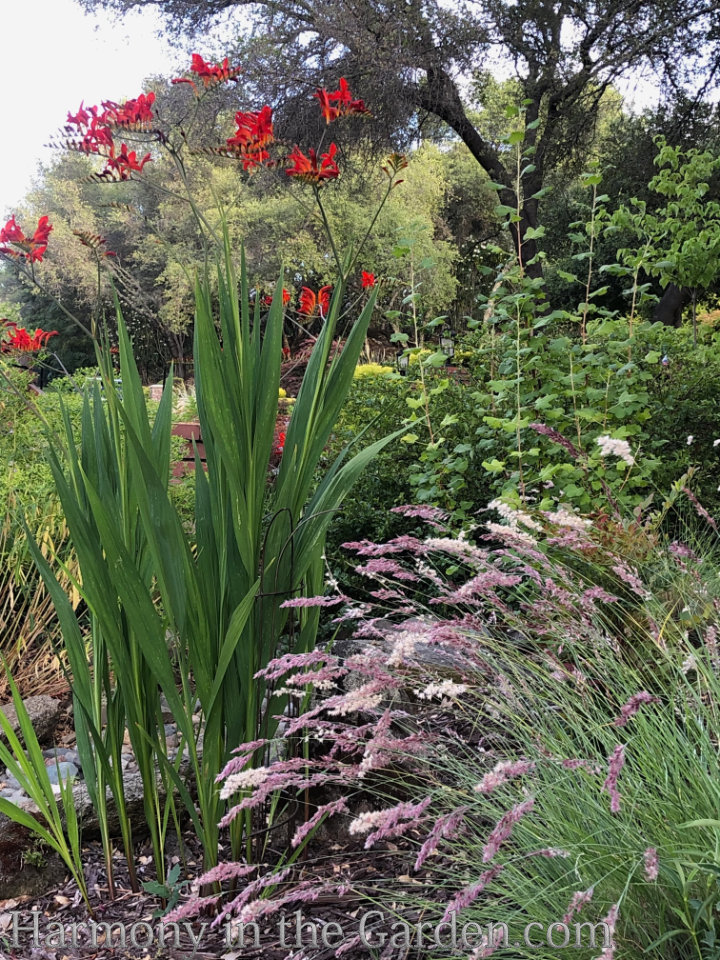
Ruby Grass (melinus nerviglumis ‘Pink Crystals’) zones 8-10
This little cutie has very thin and wispy blades topped by soft pink flower panicles that mature to a fluffy white.
The internet says it prefers more moisture, but in my garden, it receives the same watering schedule as my other drought-tolerant plants.
The colors fade to creamy white as the flowers open, creating a soft and fluffy effect.
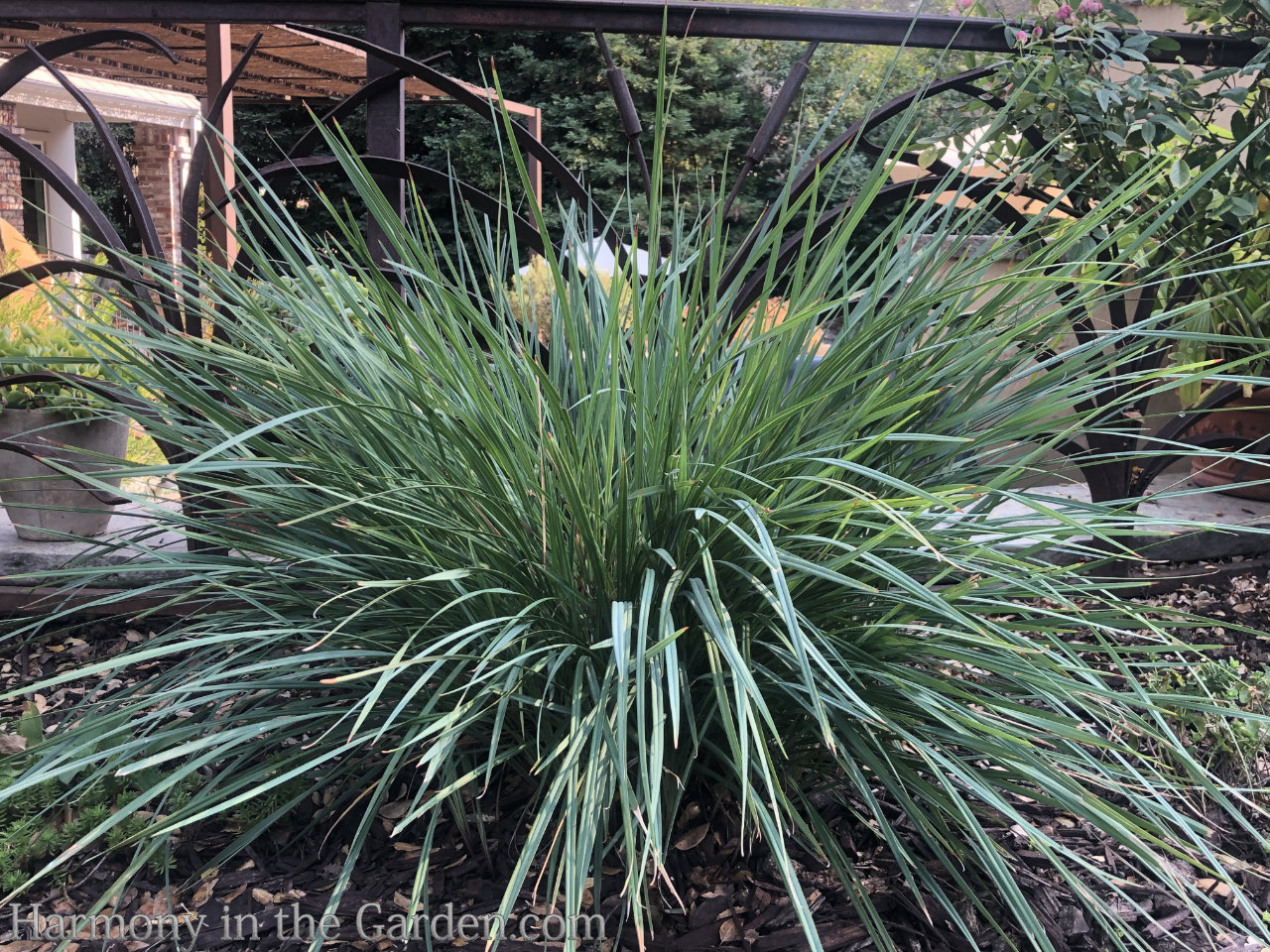
Dianella (dianella revoluta ‘Cool Vista’) zones 8-10
I’ve written about this grass before, as it’s one of my favorite evergreen varieties (available in the Sunset Western Plant Collection.)
It thrives in part shade to full sun, takes very little water, has incredible blue foliage, AND tiny little blue flowers followed by iridescent blue berries (see below pics.)
Holy cow, it’s a performer!
It’s a clumping grass that slowly spreads to 2’x3′.
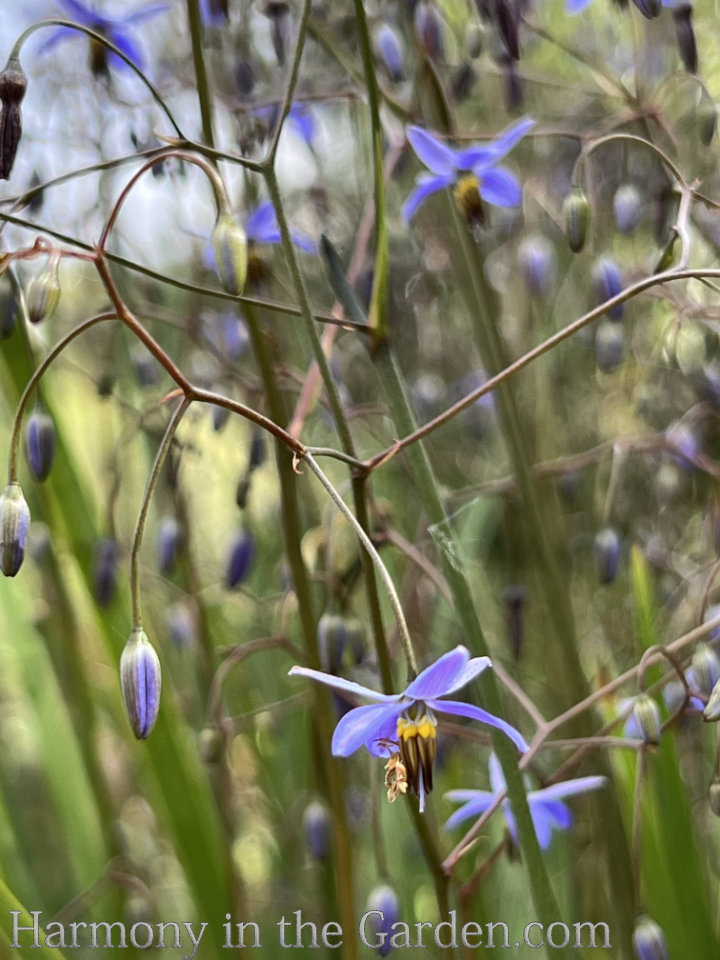
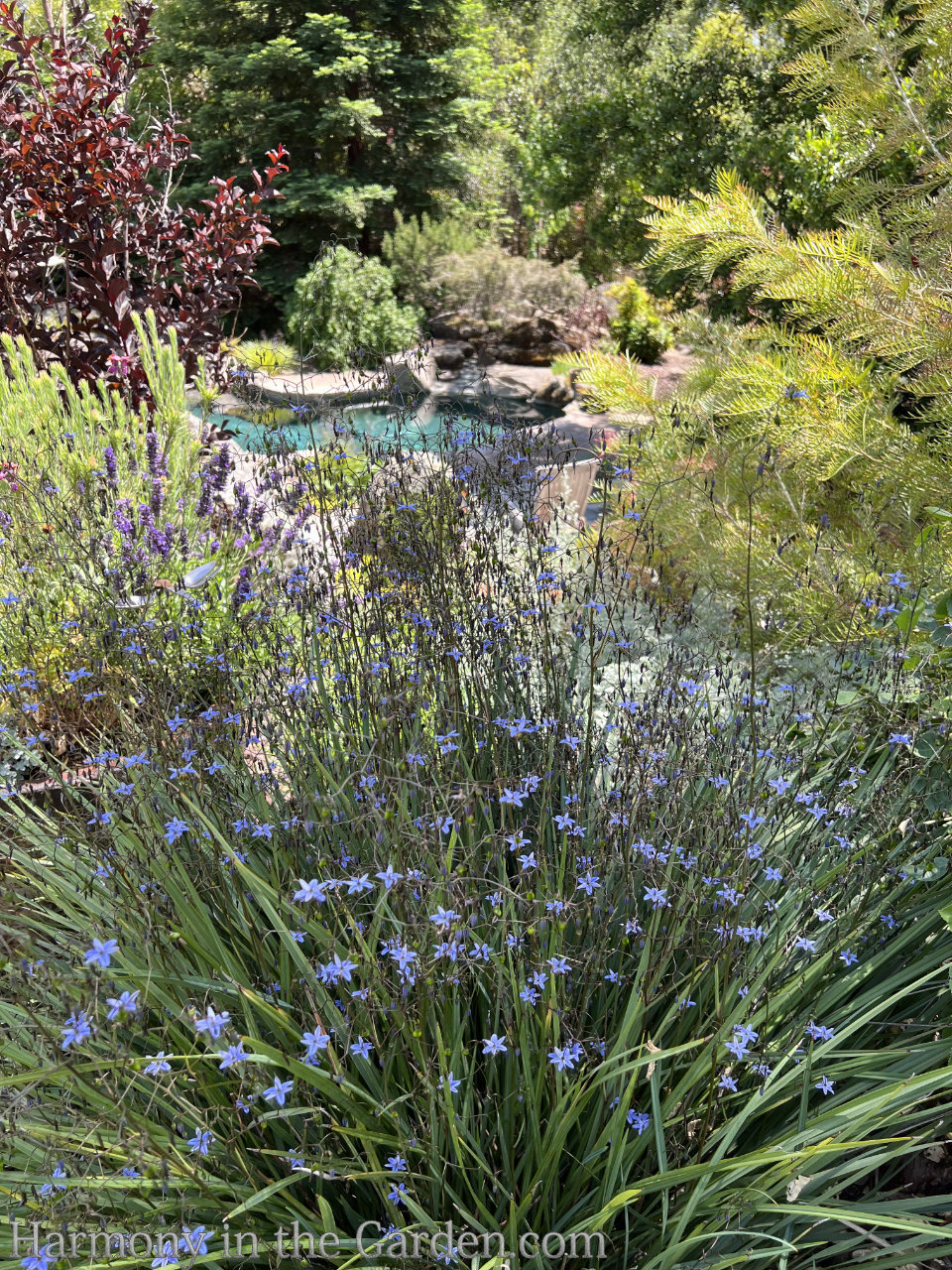
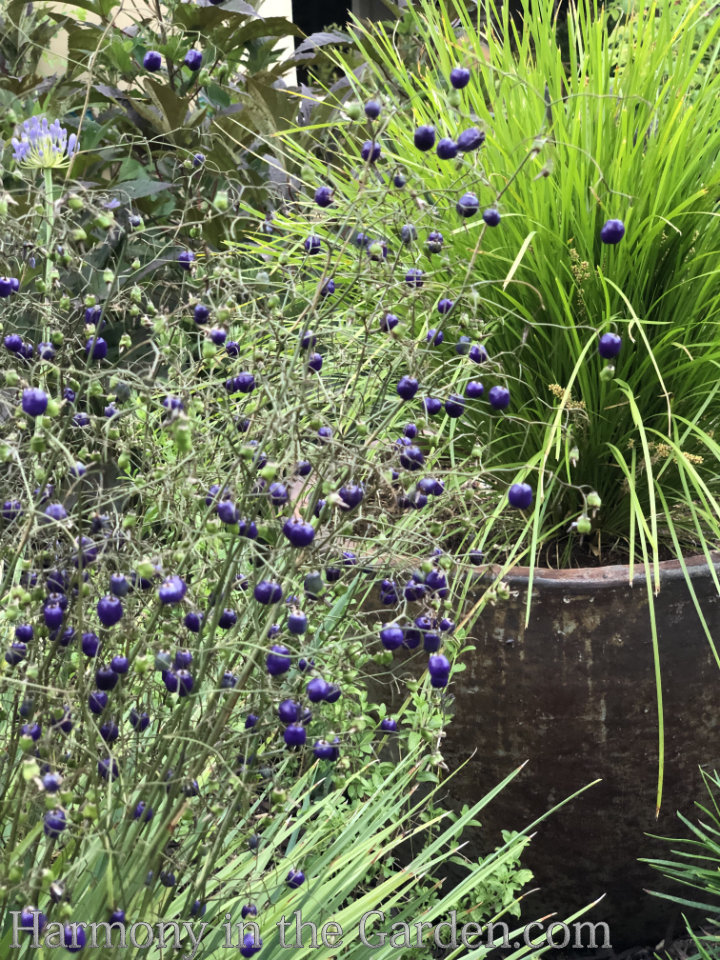
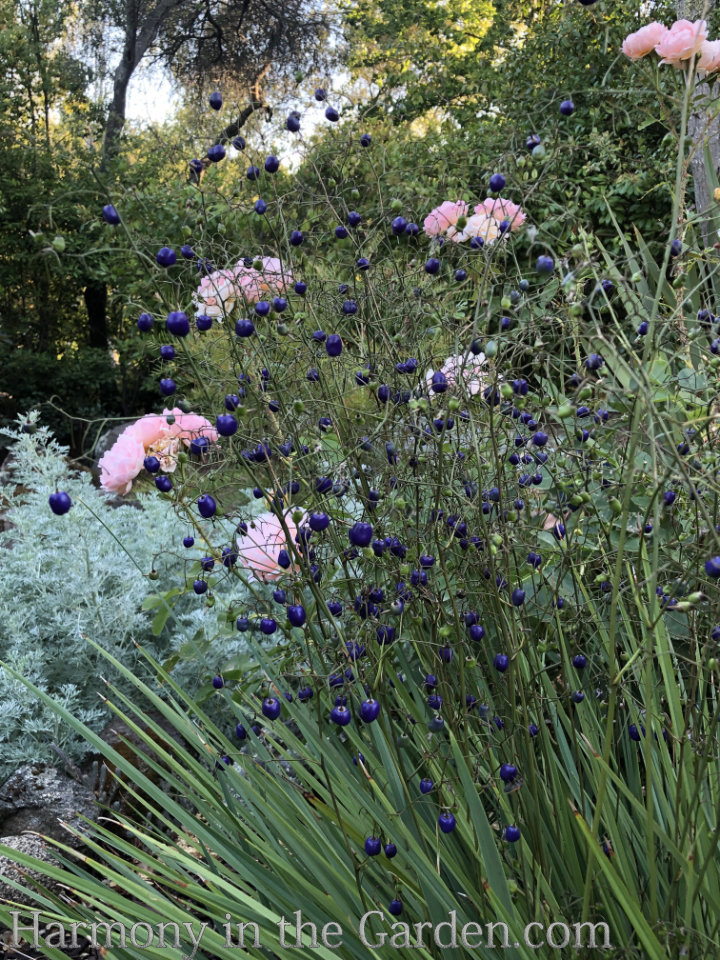
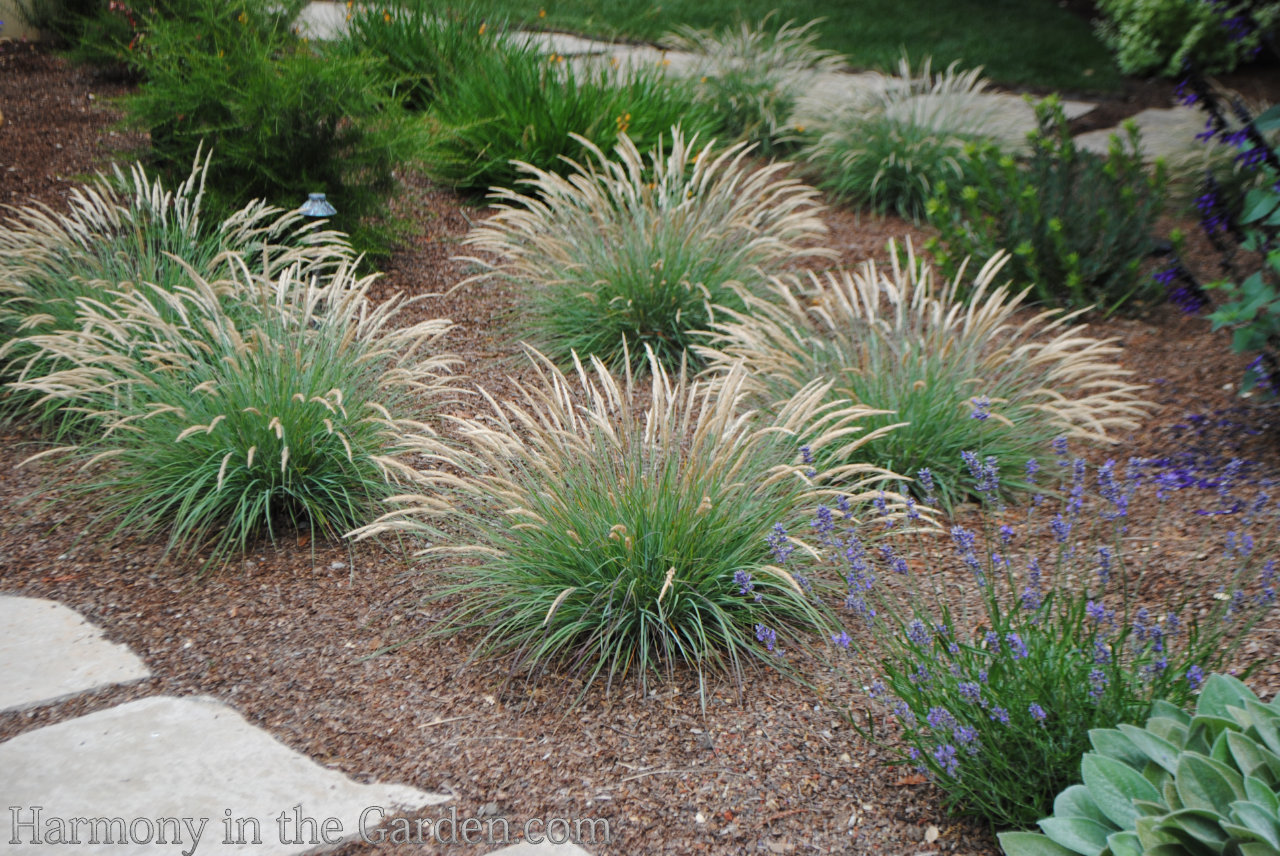
Mendocino Reed Grass (calamagrostis foliosa) zones 8-10
If tidy, clumping grasses are more your style, this calamagrostis is for you.
It’s very drought-tolerant and keeps its uniform shape throughout the year.
Its blue-green foliage is topped by tan inflorescence from spring through fall.
Middle Layer
These are the grasses that grow between 2 to 4-feet tall. They form the all-important middle section of the garden, adding fullness between other plantings or standing alone as a focal point.
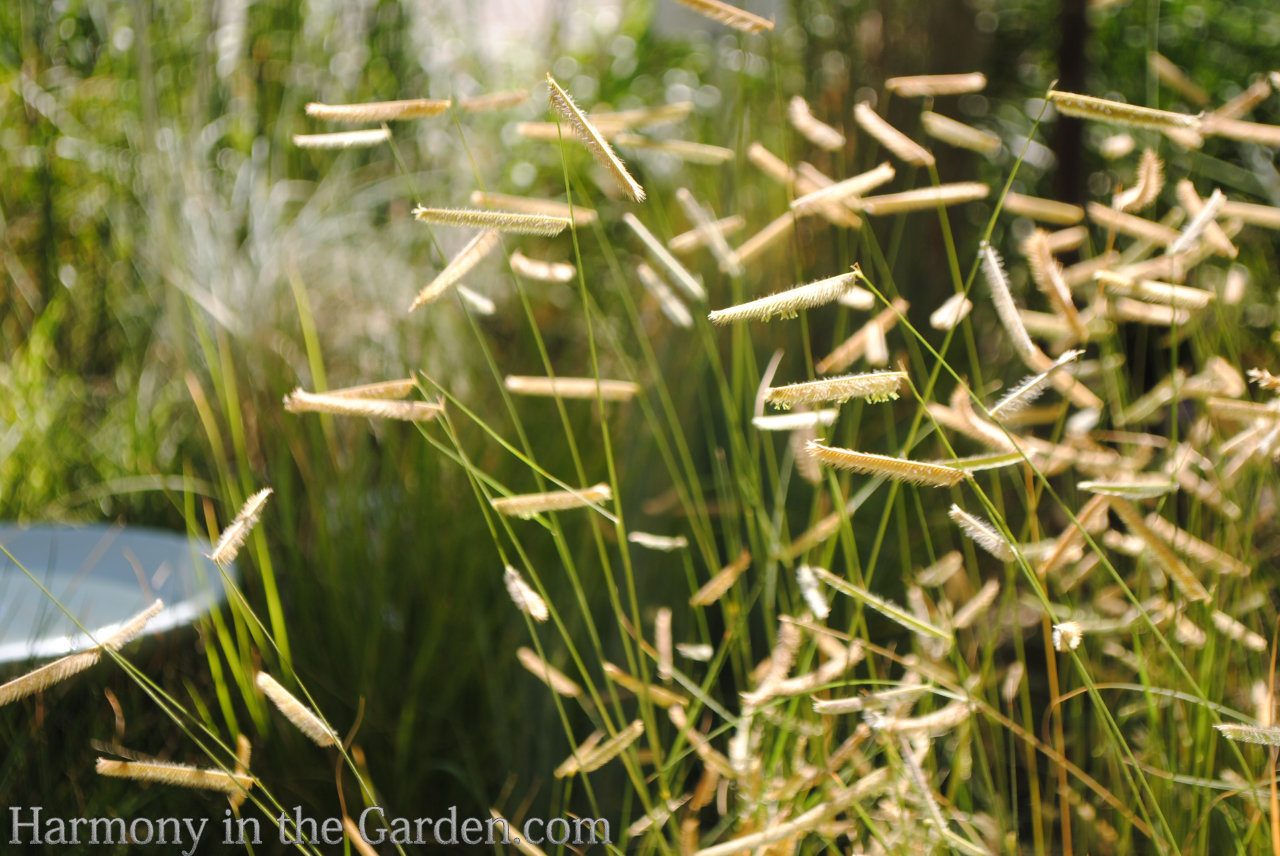
Blue Grama Grass (bouteloua gracilis ‘Blonde Ambition’) zones 4-9
Nothing adds more excitement to my fall garden than the flowers of the blue grama grass.
This 3’x3′ beauty is a must-have for a drought-tolerant garden. The delicate ‘eyelashes’ (or ‘mustaches,’ as my daughter says) wave in the wind on long, thin stems.
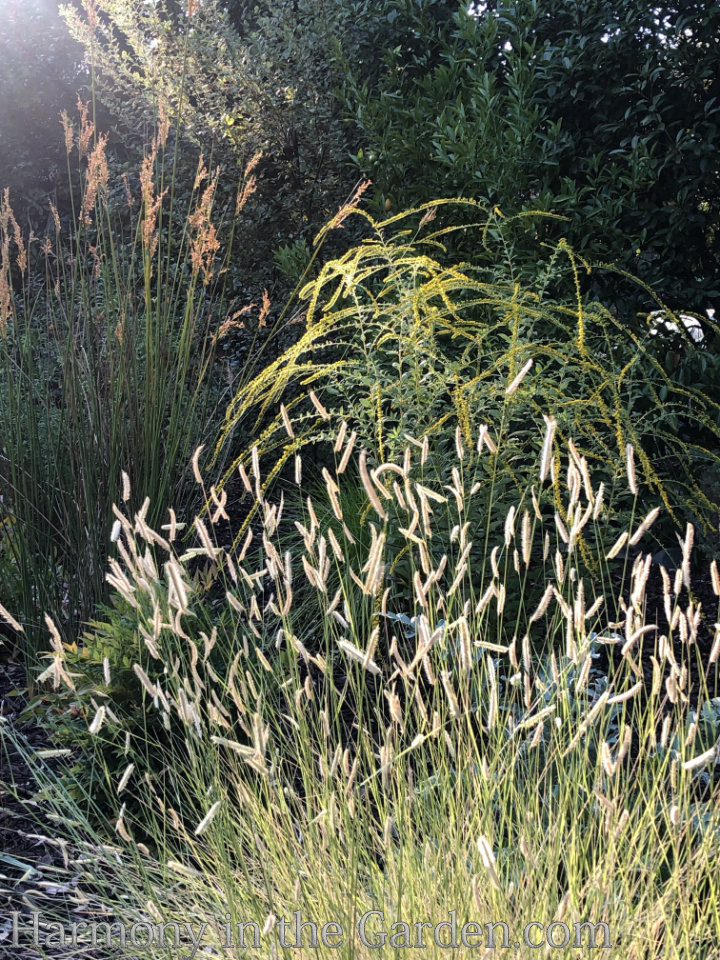
In spring through summer, the grass is a blue-green color, slowly turning tan (or ‘blonde’) as fall approaches.
It’s stunning, literally glowing across the garden when backlit by the afternoon sun.
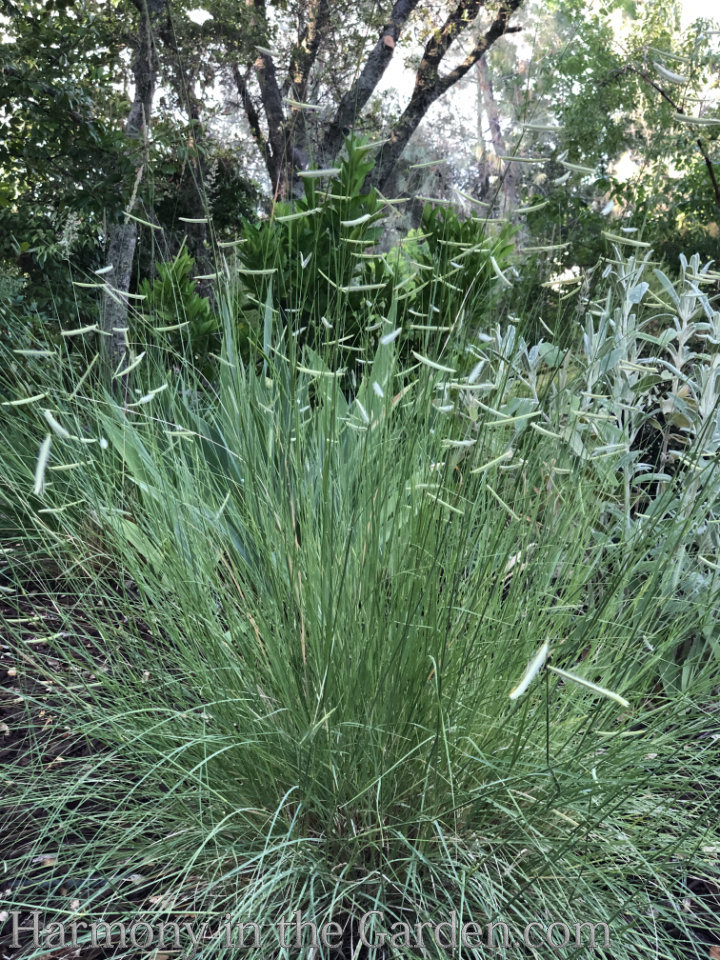
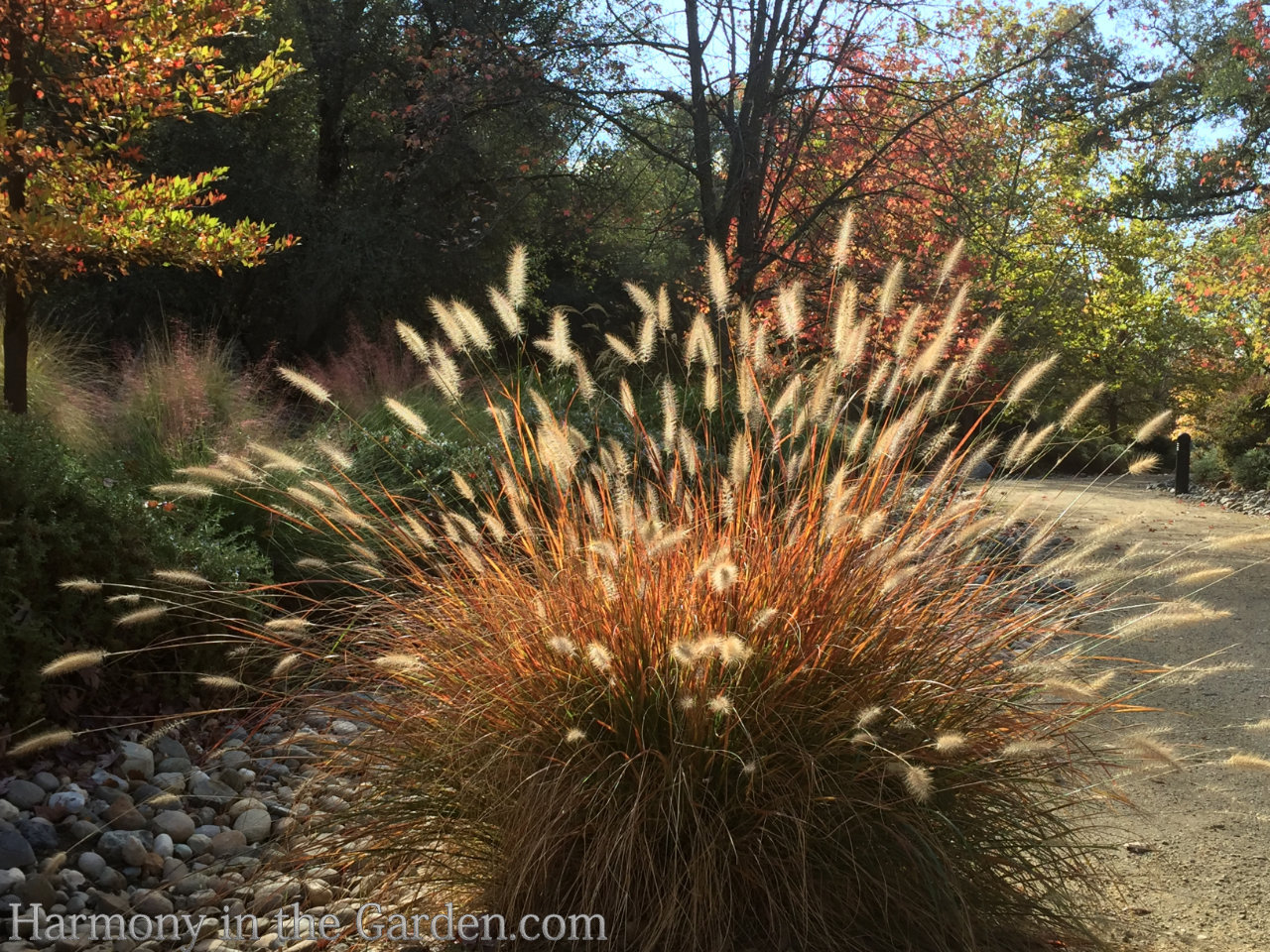
Dwarf Fountain Grass (pennisetum alopecuroides ‘Hameln’) zones 5-9
So many grasses turn shades of gold in the fall, making the red tones of ‘Hameln’ extra special.
Another very drought-tolerant variety, when in bloom, the blooms help it reach 3’x3′.
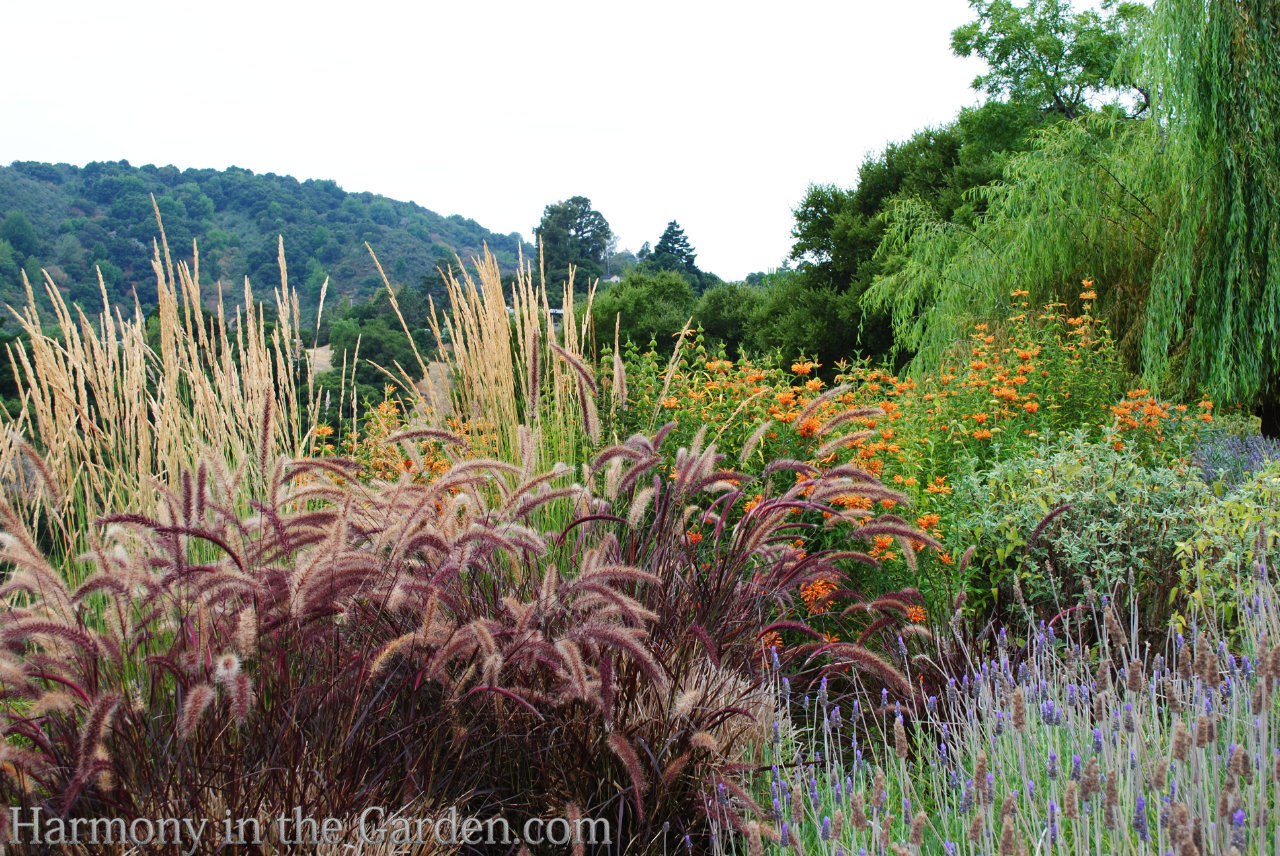
Ruby Fountain Grass (pennisetum setaceum ‘Rubrum’) zones 8-11
This is the showiest fountain grass of all, with the maroon color holding steady throughout the spring, summer, and fall.
To show off its gorgeous color, surround it with green and gray foliage.
This photo is from one of my first (and favorite) gardens I designed eons ago (click here to see more.)
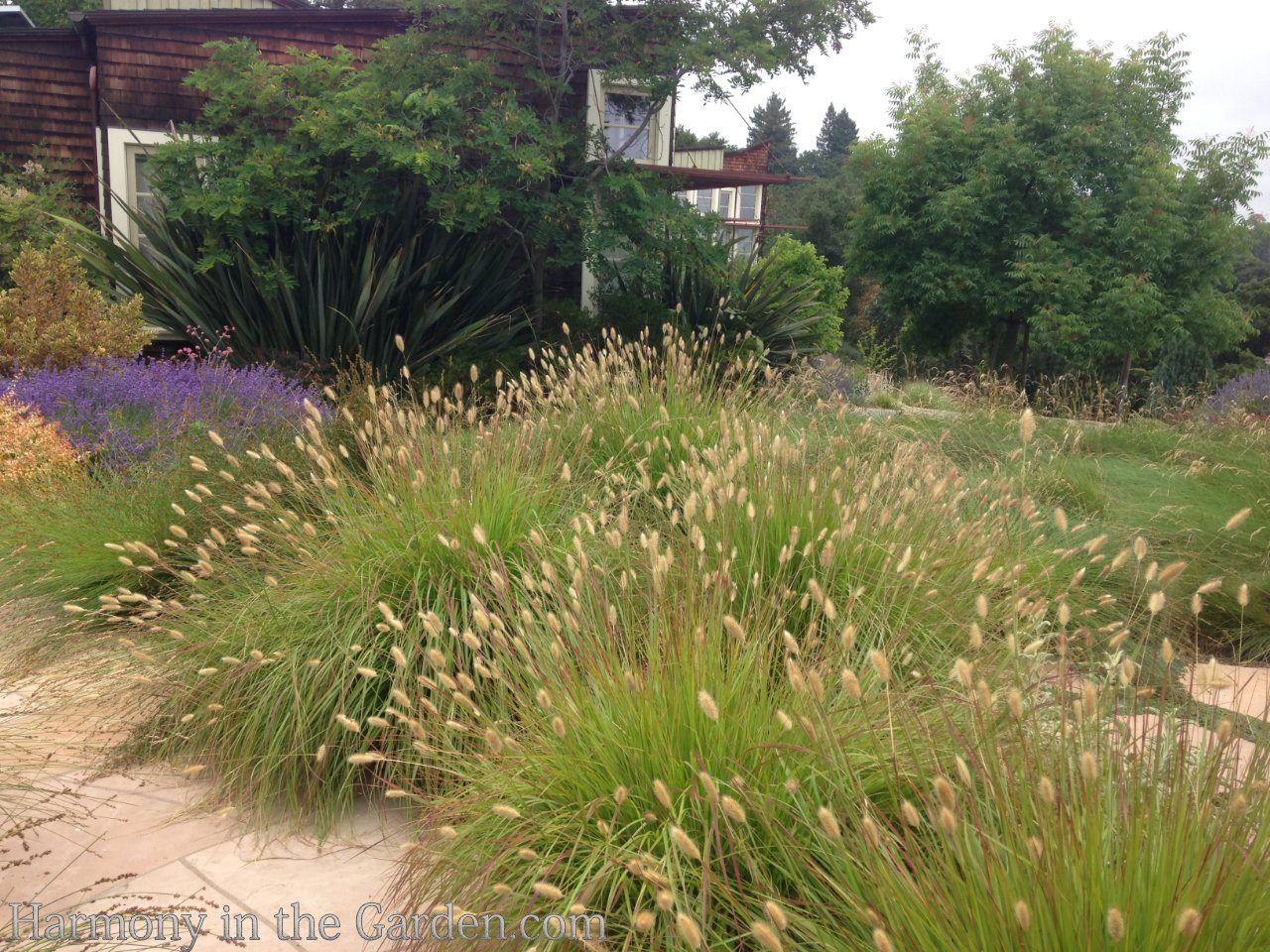
Bunny Tails (pennisetum massaicum‘Red Bunny Tails’)zones 7-10
The internet says this grass grows to 1-2′, however in my experience, it’s closer to 3′-3′ when in bloom (as shown here in my client’s garden.)
I like to plant this drought-tolerant selection when there are young kids in the family, as they can’t resist the very-touchable ‘flowers’ (not to mention the oh-so-cute name!)
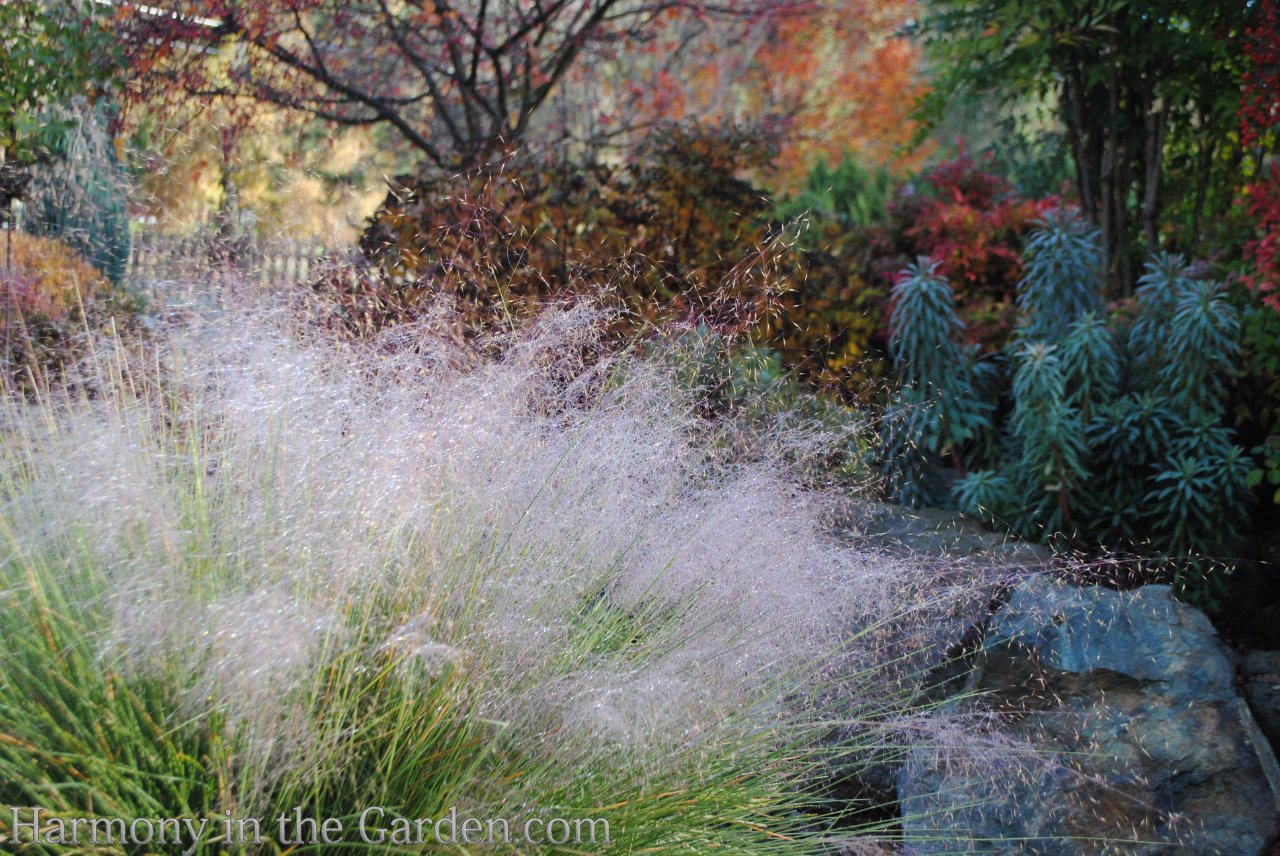
Muhly Grass (muhlenbergia capillaris) zones 7-10
There’s several varieties of this grass (some with dark pink inflorescence, even some with white!)
But I love the straight variety, with the tips blushed with a tinge of pink. It looks like the grass is topped with a fluffy cloud!
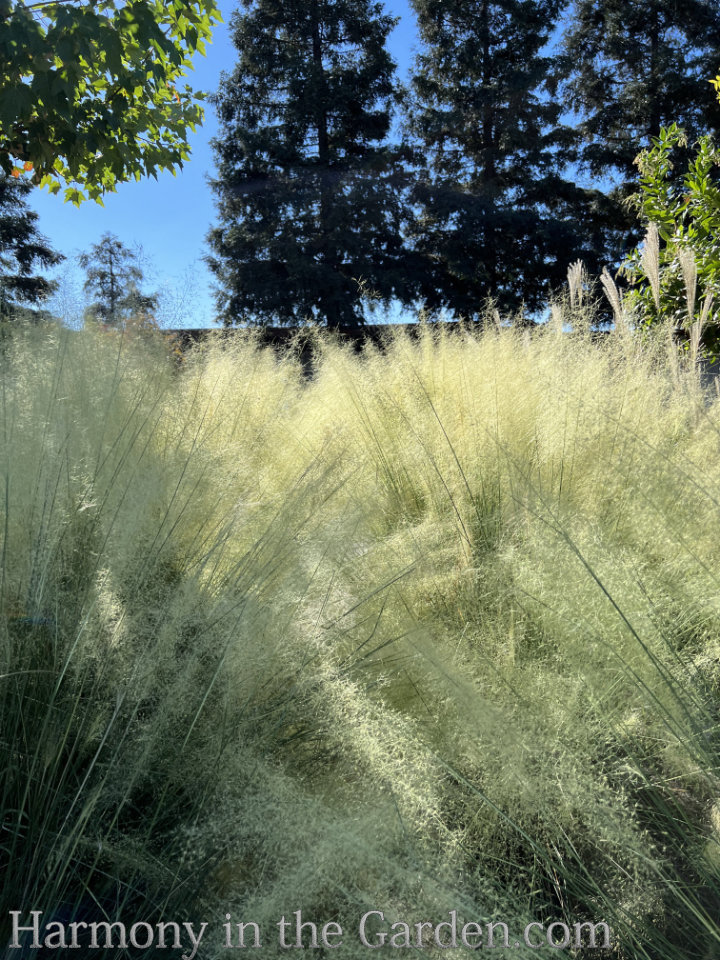
Muhlenbergia ‘White Cloud’ zones 7-10
I came upon this slope of white muhlenbergia grasses and was absolutely mesmerized by the soft white inflourescence of the grasses.
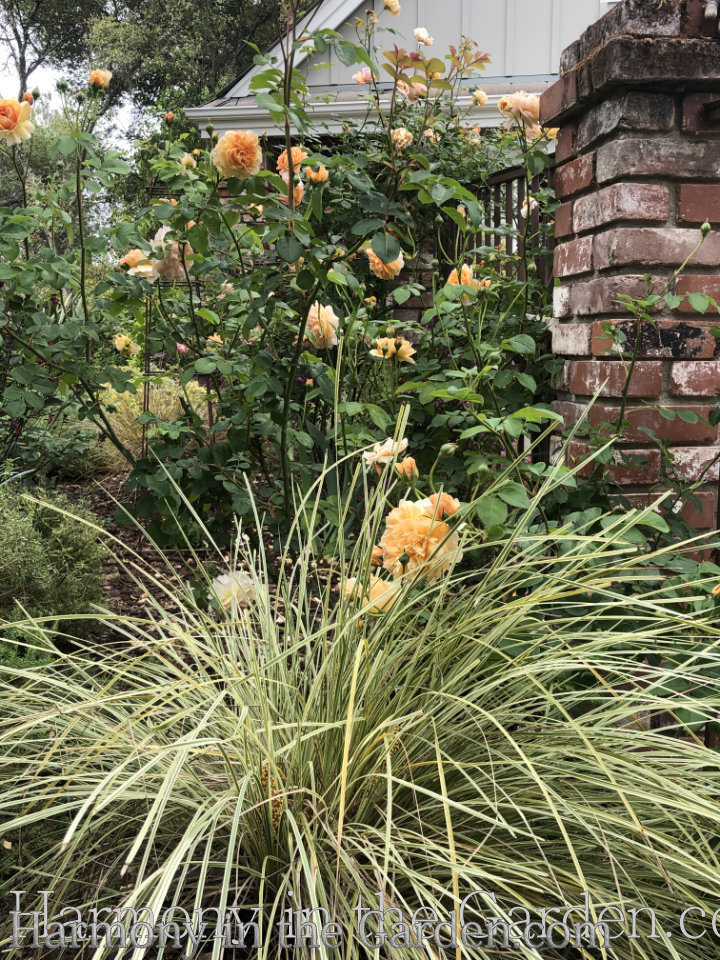
Lomandra ‘Platinum Beauty’ zones 8-10
I can’t imagine designing a garden without using lomandras. I use just about every variety I can find of these bullet-proof, evergreen grasses.
NOTHING touches them – no deer, rabbits, gophers, or drought.
And most importantly – they’re evergreen!
So in my gardens, they’re a staple, adding much-needed winter interest.
I’ll often plant them at the base of plants that are dormant in the winter, to fill in the gaps until flowers bloom again (like this ‘Platinum Beauty” at the base of my ‘Lady of Shallot’ rose.)
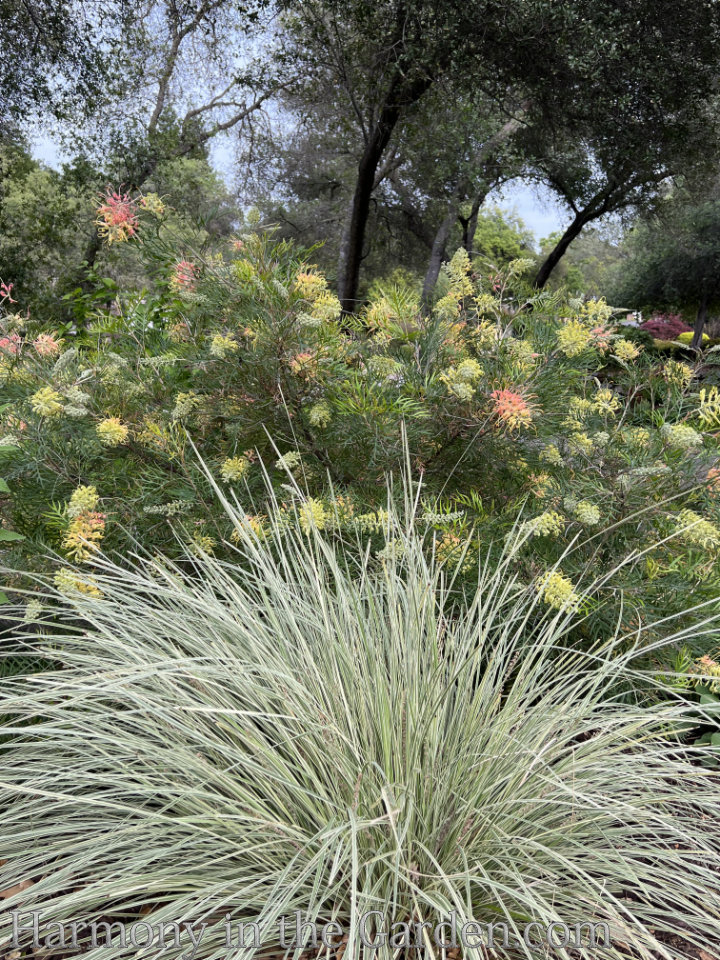
The uniquely variegated blades of ‘Platinum Beauty’ also offers some pretty amazing opportunities to create unique color echoes.
In the example, left, I’ve repeated the soft yellow of the ‘Peaches & Cream’ grevillea flowers with the creamy yellow colors in the lomandra.
This is a pretty fantastic two-plant combination that’s drought-tolerant, heat-tolerant, and evergreen in zone 9!
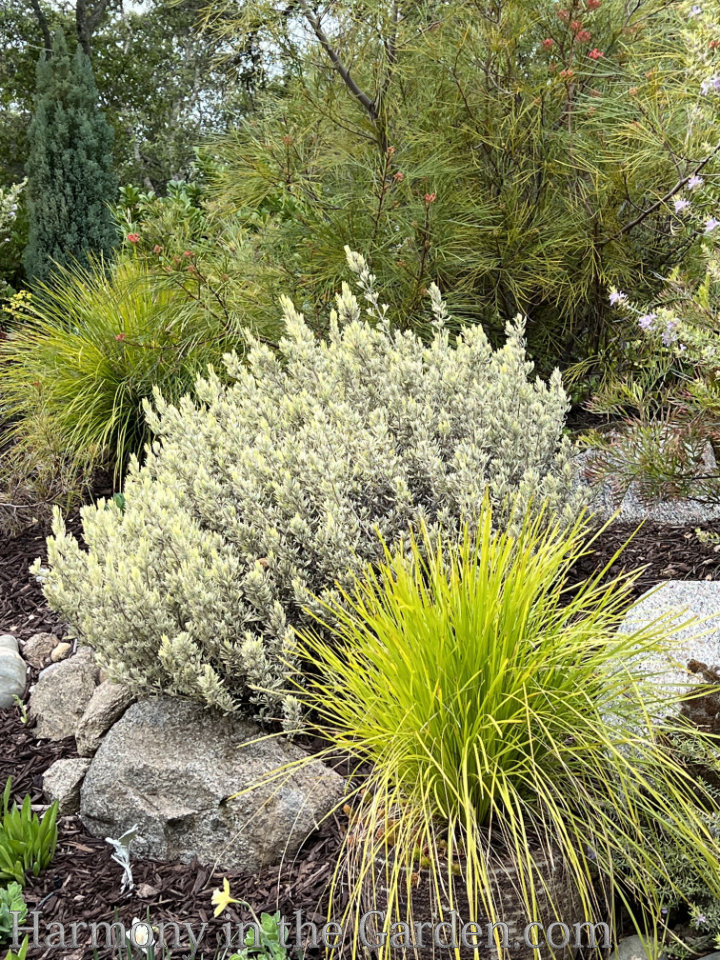
Lomandra ‘Lime Tuff’, ‘Del Sol’, and ‘Breeze’ zones 8-10
Two more of my favorite lomandra varieties are ‘Lime Tuff’ and ‘Del Sol.’
The main difference between the two is ‘Del Sol’ is bright yellow-chartreuse whereas ‘Lime Tuff’ is bright green.
Both grow to about 2.5′ x 2.5′ and are FABULOUS.
I often plant them in containers nestled within a planting bed (like the ‘Del Sol’, left, planted in a brown container near a ‘Meerlo’ lavender.)
The photo bottom, left, has another ‘Del Sol’ in a chocolate brown container discreetly placed within the garden bed. That’s a blue-green dianella in the front, by the way.
The antique container (below, right) is home to a ‘Lime Tuff’ lomandra with a trailing silene ‘Druett’s Variegated’ cascading over the edge.
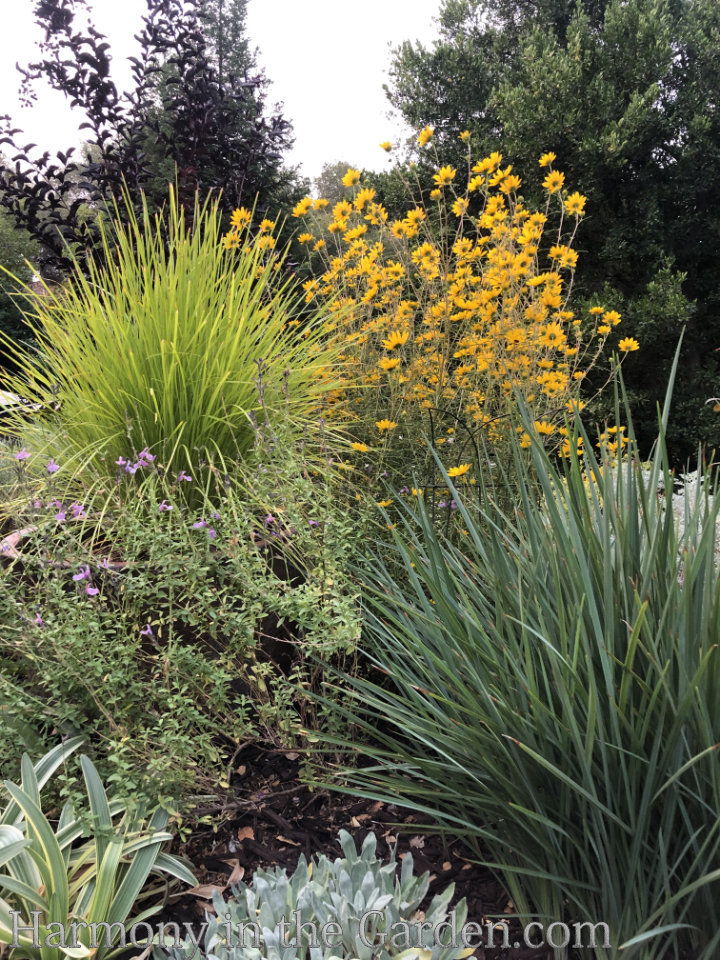
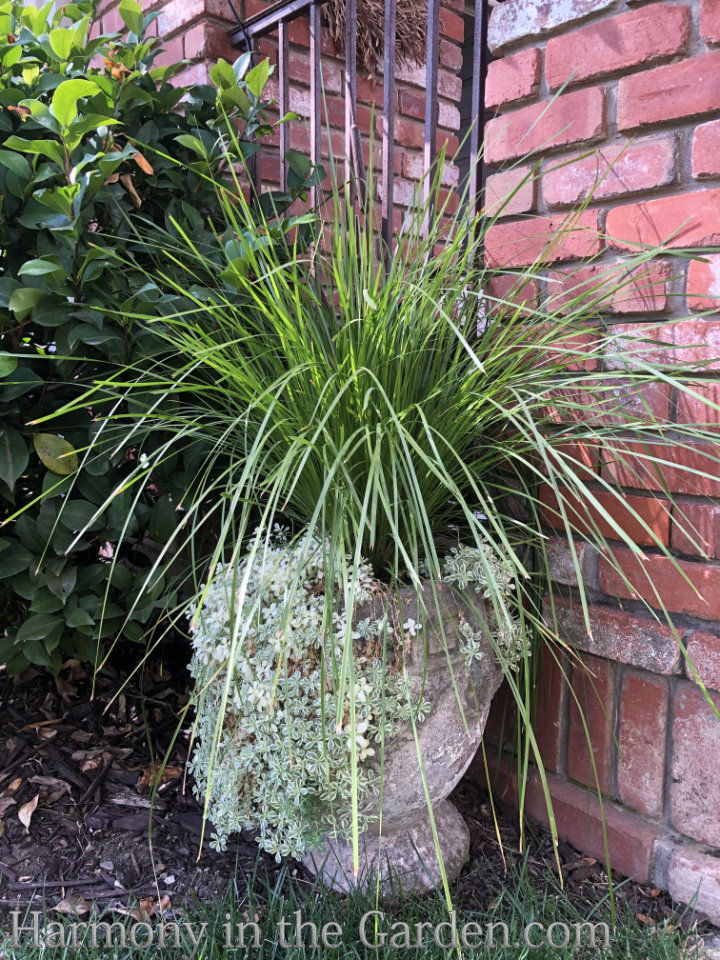

Lomandra ‘Breeze’ is another variety that has been a favorite of designers for the past decade or so. It’s a big one, topping out at 3′ x 4′ wide (sometimes a bit taller, if it’s really happy.)
It’s very tough, and I’ve used it for years in tons of gardens I’ve designed.
In my client’s garden, left, it provides ‘heft’ and ‘bulk’ among neighboring plants of similar size, while standing out from the crowd thanks to its contrasting, fine foliage.
Click here to read more about creating a tiered garden.

Feather Reed Grass (calamagrostis ‘Overdam’) zones 4-9
A stunning mid-sized calamagrostis, ‘Overdam’ is equally happy in full, hot sun or partial shade.
When its summer blooms appear, they’re particularly stunning when backlit by the sun.

Top Layer
These are the biggies that grow upwards of 4-feet, used as stand-alone focal points or the backbone of garden beds. If you’ve read my blog for any length of time, you know I’m a sucker for super tall plants (click here for proof!)

Pennisetum ‘Fairy Tails’ zones 7-10
Ever since I first saw the amazing drift of ‘Fairy Tails’ at Cornerstone Gardens (below), I knew I had to include this in my garden.
It’s a drought-tolerant grass, but if given a bit more water, it gets HUGE. As in 6′-7′ tall!
I have two of them planted at the beginning of my driveway (you can read more about this part of my garden here.)
There’s another planted further up on the hill, where it’s a much drier location, and it only grows to 5′ tall.
It’s the chenille-like tassels that steal the show, just begging to be touched by all who pass.
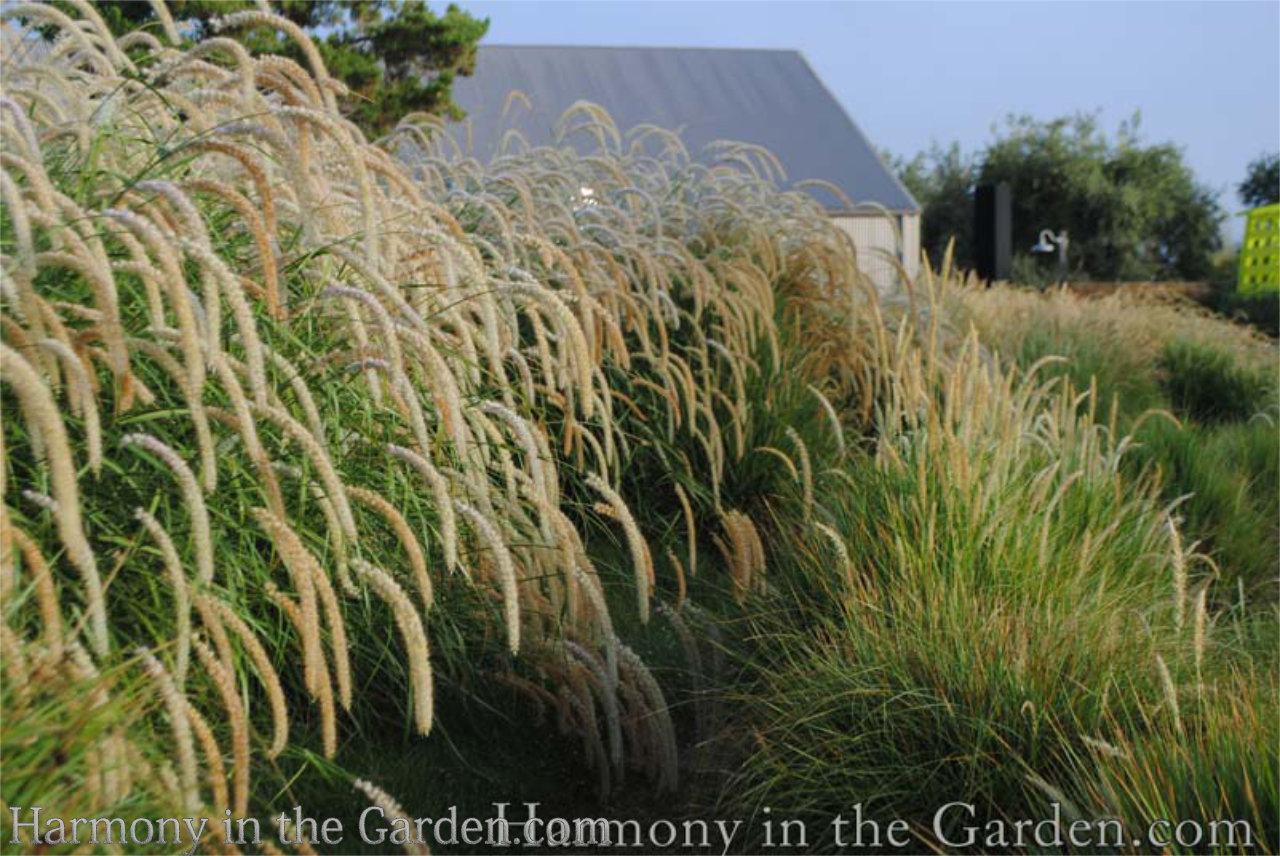
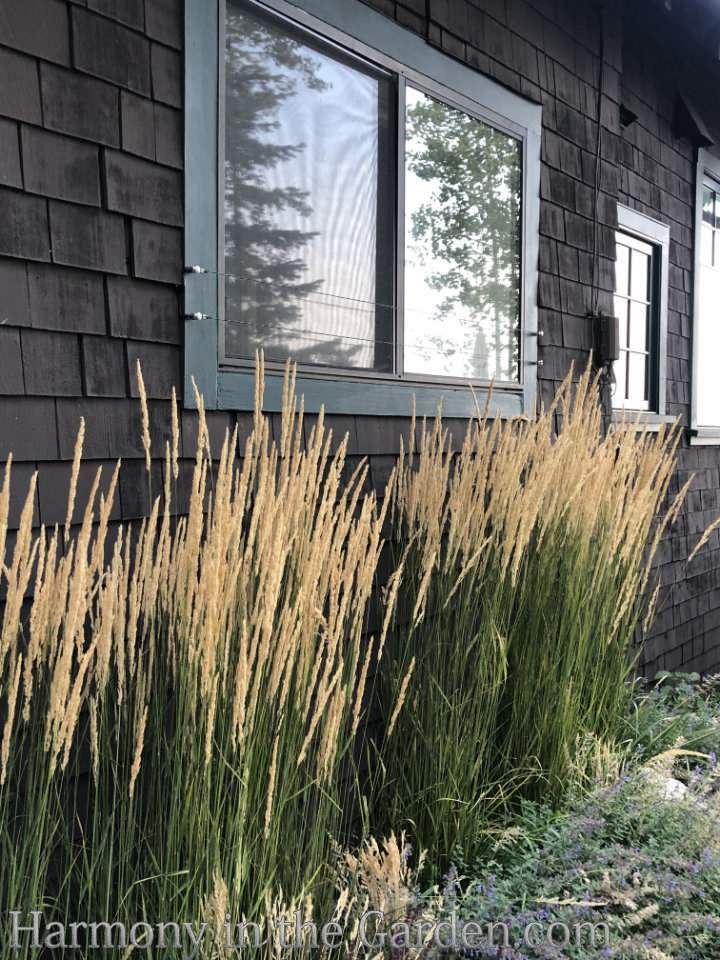
Feather Reed Grass (calamagrostis acutiflora ‘Karl Foerster’) zones 4-9
I can’t write about towering grasses without mentioning ‘Karl Foerster.’ It provides a tall, vertical accent without the width, making it ideal for tight spaces.
Low-water, deer-resistant, and provides a wow-moment in the garden – what’s not to love!
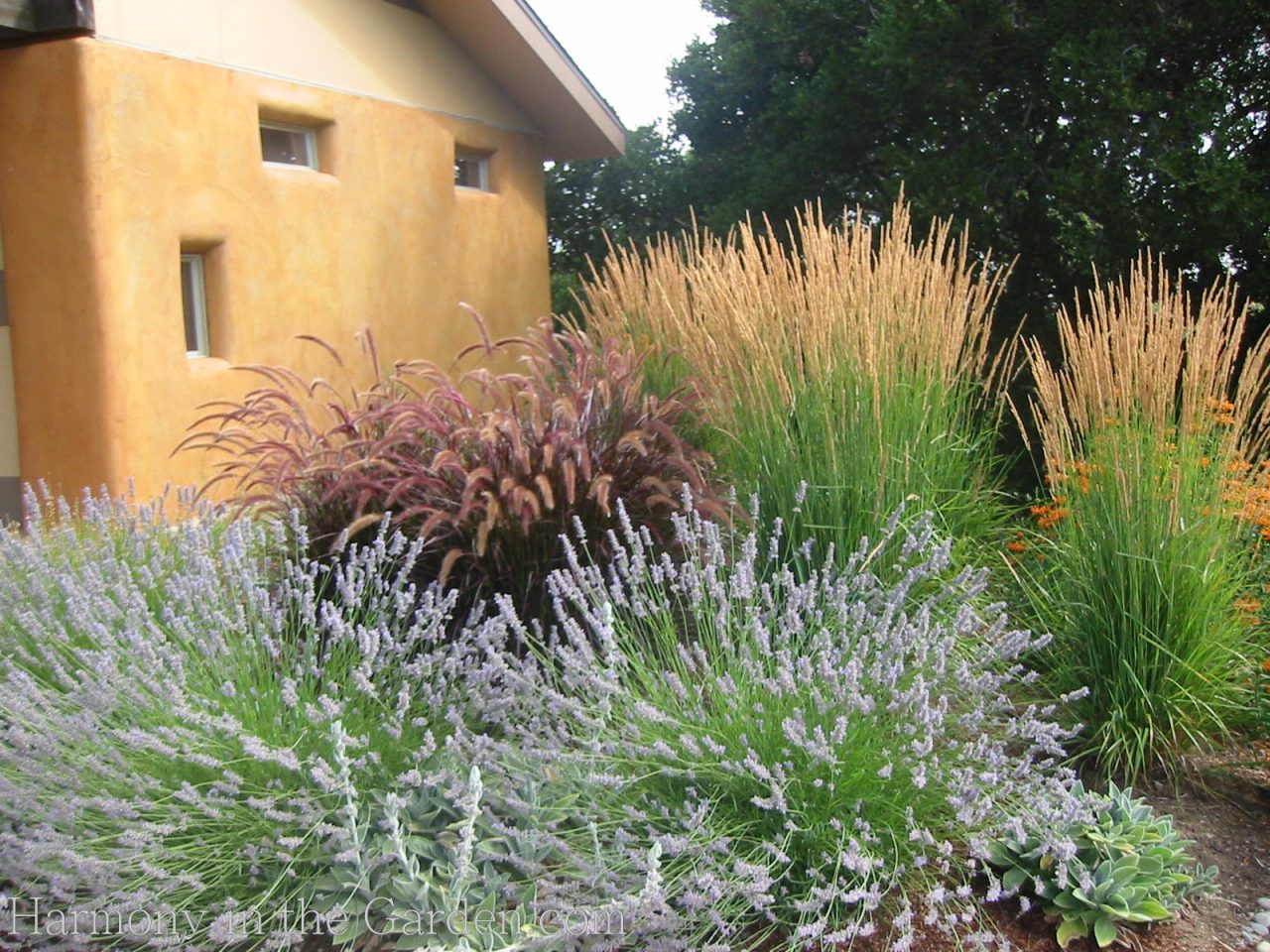
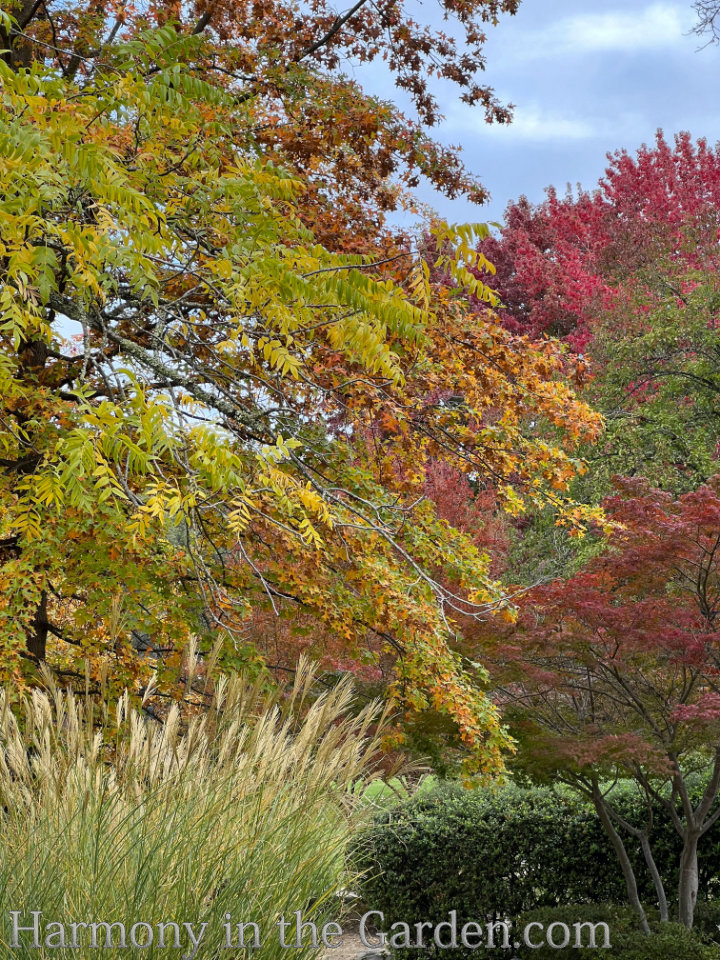
Chinese Silver Grass (miscanthus chinensis ‘Gracillimus’) zones 5-9
Miscanthus comes in just about any size you could desire, from the dwarf ‘Kitten’ variety that grows to 2’x2,’ to the towering giganteus that soars to 12′ or more.
This is a stunning, full-bodied grass with wispy foliage and incredibly showy tassels late summer through fall.
It’s when the tassels turn into seeds, however, that can make this grass problematic as it can be very invasive in climates with regular water.


Always check to see if miscanthus is invasive in your state, as there are very few truly sterile varieties (‘Cabaret’ and the giganteus variety being two of them.)
If it’s safe to plant in your area, lucky you!
It’s a gorgeous addition to the border, adding a calming and serene element, while providing mass, as is demonstrated (right) in this deep border at Central Park’s Conservatory Garden.
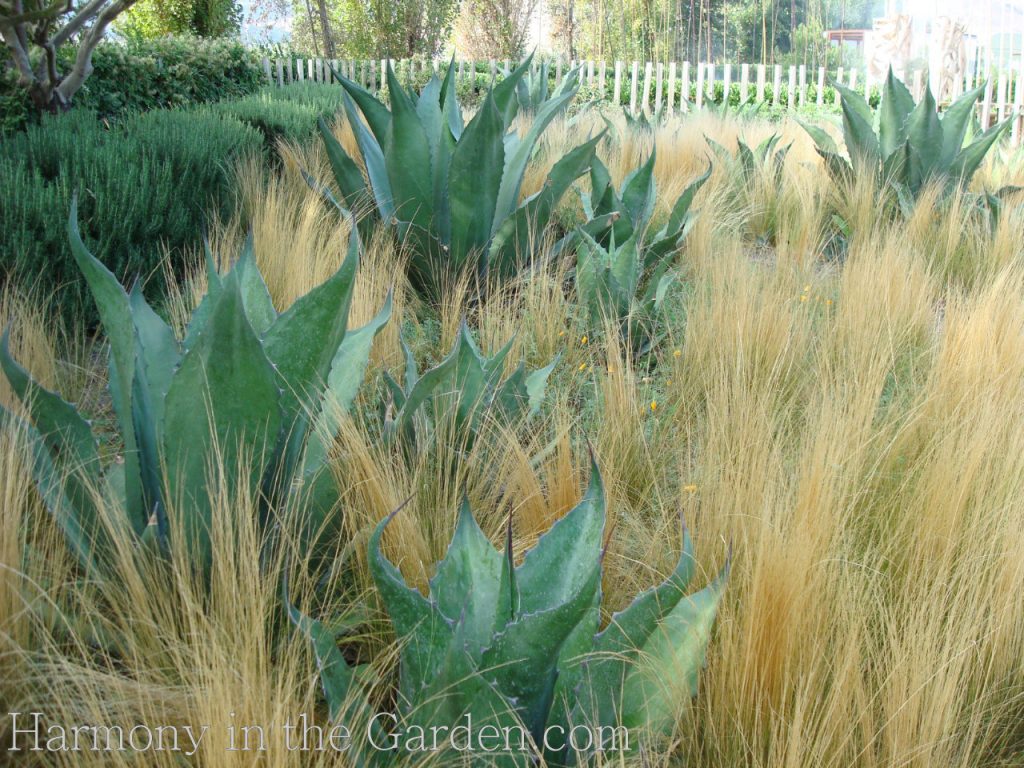
In wrapping up this post, I wanted to share with you one of my favorite combinations of all from The Garden of Contrast, created by the team of Oehme, van Sweden.
The simplicity of this combination is nothing short of genius.
The oversized agave, surrounded by the finely textured, ‘broom-like’ grasses takes my breath away every time I see it.
If you’d like to learn a bit more about using ornamental grass, I highly recommend Grasses, by Nancy J. Ondra and Saxon Holt.
And, for a fantastic in-depth article re: designing with sedges, click here:
And finally, click here for a fantastic tutorial on how to prune back an overgrown grass.
So next time you’re at the nursery, I hope you see ornamental grasses in a whole new light.
And if you have any favorites, or creative ways to use them in your garden, please share them with us!






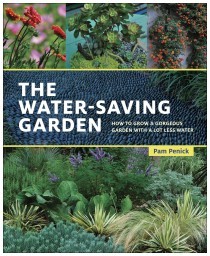
14 Comments
hello I absolutely love your website. I got the names for grasses that I’ve owned in the past but never knew what they were called. can you tell me if two of these are perennials? one is the Ruby fountain and the other one is the Mendocino reed grass. I also wanted to ask you if you know of a website where I can get ideas on how to lay out the plants in my garden I have six of them. I can’t find any websites that show me what plans to put where to give it the best visual effect. thank you again so much for your site. sincerely Orah
Hello Orah – I’m so glad my post helped you, and yes those two grasses should be perennial in most areas, except in really cold climates, so check your USDA Zone first just to make sure. ie: they most likely wouldn’t make it through our zone 6 Lake Tahoe winters. I don’t have a specific website for plant layout to recommend, unfortunately. If you’re interested in a virtual consultation, however, take a look at the ‘design services’ tab on my website to see if that might help. Best of luck!
Perfectly timed post as I’ve been thinking about using more grasses in my front garden – I have a total of one so far (Blue Grama Grass) but it has done surprisingly well over our hot Bay Area dry season which lasts a good 6 months. I’d forgotten about it and then one day noticed a very cool looking green fountain of grass among the Agaves. I’d given the area a few deep waters over the summer – but never went out of my way to water the grass itself. I was pleasantly surprised.
Is it considered good practice to cut this grass to ground over the winter?
Hi Hans, I’ve gardened with the Blue Grama Grass for years and cut them back once they’re completely tan/dead on top (usually in December or so.) If you don’t, a wind storm will blow the blades all over your garden (same with the Hakone grass and other pennisetums) which is such a pain to clean up. I leave the dying blades on as long as I think I can get away with, as it still adds winter interest, and if there’s any dried seed heads the birds appreciate the snack, but once I see a big windstorm is coming, I cut it back. Good luck!
You have perfect timing as I am in the process wanting more grasses in couple of locations and making lists. Several grasses will have to be crossed off my list now as you have them zone 7 and I am in zone 6. Thank you for this information, really enjoyed article.
You’re so welcome, Frieda, I’m glad you enjoyed the article. Before you cross some of the grasses off your list you might try and ask around at your local nursery, or check local sites to see if they’ll live in your climate. I’ve found that half the time I’m able to have decent luck at pushing the limits in terms of zones. It might be worth exploring a bit more. Good luck!
Wonderfully informative article!
Thank you, Candace, I’m glad you enjoyed it!
I live in Nevada County, but often find myself in the Auburn and Roseville areas. Can you recommend nurseries these areas that carry a wide variety of grasses?
Thanks for your valuable information and insights. Oh, and there’s a new Green Acres in Auburn (they bought Eisleys, near the old Auburn cemetery, and while I haven’t been I heard they really expanded and have a large selection.)
Hi Bill, I’ve had pretty good luck finding grasses at Green Acres (the one on Harding & the one on the Crossings) – both have had a lot of grass selections. I’m glad you enjoyed the article – grasses are so perfect for our climate!
What a wonderful article about grasses. I have started to use them in my garden, but don’t always see the variety you share here. This list will help me find the variety I need rather than settle for the limited choice I sometimes find at the nurseries. Thank you!
I’m glad you like the article, Gayna, and for what its worth, I’ve had really good luck with plants (grasses, too) that I’ve purchased online from Digging Dog Nursery and High Country Gardens. You might give them a try.
Thank you for this timely and educational article about using Grasses in the landscape. I am a landscape contractor/designer in the Carmel, CA area and use them more and more and this year began incorporating them into my own garden. They are effective, playful and a joy to behold.
Nice to meet a fellow-designer, Catherine, and I’m glad you enjoyed my article!